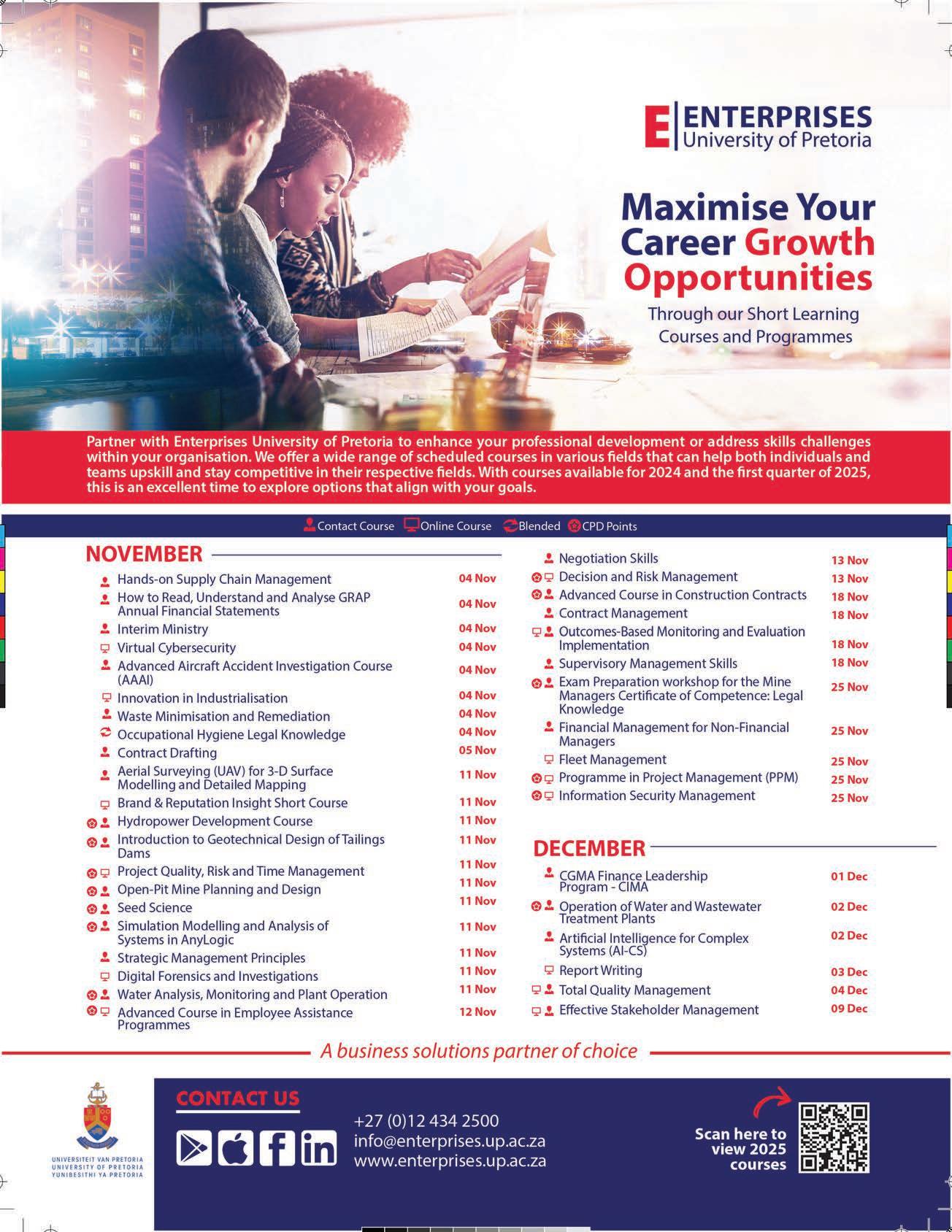








































Over the past few years, our contribution increases were well below the industry average.
However, while the Fund is performing well, we have to balance nancial sustainability with enriched bene ts.
For this reason, contribution increases range from 8.7* to 14.9 per cent* per plan (the latter impacting 1 per cent of members) with a weighted increase of 10.2 per cent* from 1 January 2025.
Bonitas members in local government can pay from as little as R1 009 per month on BonFit Select as part of their subsidised rates.
Our members are from a diverse range of backgrounds with pro les varying from students and singles to families, established professionals and retirees.
Our new model is designed to revitalise our approach based on industry, life stage and various psychographic and behavioural science elements. This is supported by a diverse product range, tailored wellness and screening bene ts, access to healthcare services and optimised member communication.
We continue to make health risk assessments and preventative care screenings pivotal to managed healthcare initiatives. Early detection and intervention is critical. Half our population has high blood pressure and one blood pressure monitor will be funded over a two-year cycle per family.
Members still only pay for a maximum of three children – depending on their plan – and dependants up to age 24 pay child rates.
Integrated chronic care family practitioner network. For 2025, we have added a mental health component to our GP network to facilitate early disease detection, diagnosis and multidisciplinary care co-ordination. This is in addition to the Mental Health Programme available on all our plans.
Hearing Loss Management. This includes free online hearing screening. Members on selected plans will receive hearing aids, audiology services and hearing aid acoustic services.
Weight Management Programme. This programme, led by a biokineticist, provides a holistic approach to weight loss that includes access to a dietician and psychologist for support on exercise, nutrition and mental health.
Female Health Programme. We’re committed to the health and wellbeing of women and toddlers through the Mother and Child Care Bene t, including the Maternity Programme. Launched earlier this year, the Female Health Programme emphasises preventative care and early detection of female-speci c health issues based on life stages.
Maternity Programme. This comprehensive programme includes support for expecting mothers, including early identi cation and weekly engagement for high-risk pregnancies, antenatal vitamins, post-childbirth care and associated mother mental health follow-up calls. There are also milestone reminders for children under three, immunisation reminders and online screenings for infant and toddler health. Vision screening by an ophthalmologist for premature neonates is offered on all options, except BonCap.

Diabetic retinopathy screenings. Members can access cutting-edge diabetic retinopathy screenings.
Benefit Booster. We are offering more value for money on the Bene t Booster, which gives up to R5 000 as an additional bene t for out-of-hospital expenses, at no extra cost.
We continue to run a tight ship while meeting the diverse needs of our members with innovative bene ts, a life stage model and a commitment to quality care.
*The increases and new benefits have been submitted to the CMS and are subject to their approval.


For more information: 0860002108 0600702491 queries@bonitas.co.za www.bonitas.co.za
3 SALGA FOREWORD
Despite the challenges of the past 30 years, e orts to entrench democracy and improve the quality of life for everyone continues.
9 OUTLOOK
The most important Sustainable Development Goals for South Africa’s youth 10 IN BRIEF
A roundup of news from around the globe.
11 ENERGY
With more than 600 million people across Africa lacking access to electricity, the International Energy Agency estimates that Africa will need to double its electricity generation capacity by 2040 to meet growing demand.
WATER INFRASTRUCTURE
13 A critical analysis of the establishment of the South African National Water Resources Infrastructure Agency as outlined in the recently approved bill
30 YEARS ON
14 While municipalities continue to be at the heart of building inclusive and sustainable communities, the battle to live up to this ideal has often been uphill.
18 As political parties jostle for power, the reality is that no matter who leads us forward, there is only one real solution to re-energising socioeconomic growth and development: industrialisation.
20 Unpacking the critical need for sustainable and solution-oriented approaches to youth development to secure a brighter future for our nation.
THE LAND ISSUE
24 Geographic information systems technology is revolutionising municipal property management globally by delivering accurate, up-to-date information that can empower local governments to make informed decisions.
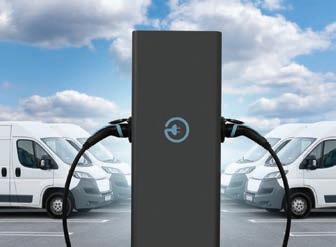

25 Unpacking the intricacies of releasing well-located public land for a ordable housing by drawing on the experiences of Cape Town, eThekwini, Johannesburg and Tshwane metropolitan municipalities.
26 While there have been several government policies for urban integration and land transformation since 1994, progress on the ground has been limited.
34 There are many economic and environmental bene ts for the South African taxi industry in moving towards electric vehicles. But that means dealing with a complex web of issues.
36 Political will and funding are crucial for improving road safety in South Africa, emphasising shared responsibility and behavioural change among road users for better outcomes.
37 As cities worldwide race to modernise, South Africa nds itself on the brink of a smart city revolution.
38 The South African government’s recent policy shift points the country squarely to the cloud.
SERVICE DELIVERY
41 OUTLOOK
Key ndings from the Governance Performance Index – South Africa 2024.
42 A roundup of municipal projects from around the country.

Director, Marketing & Communication: Tebogo Mosala
Communication & Marketing Officer: Marelda Boshielo
Marketing Officer: Valerie Setshedi
PICASSO EDITORIAL & PRODUCTION TEAM
Content Manager: Raina Julies, rainaj@picasso.co.za
Contributors: MJ Booysen, Dr Zizamele Cebekhulu-Makhaza, Bazil Govender, Matthew Hirsch, A Jahur, Makgati Makgatho, Vuyo Mazabane, Jeff Mkhwanazi, Itumeleng Mogaki, Busani Moyo, Calvin Nchabeleng, Carrie Peter, Brendon Petersen, MJWA Vanderschuren, Lisa Witepski
Copy Editor: Brenda Bryden
Content Co-ordinator: Natasha Maneveldt
Head of Design: Jayne Macé-Ferguson
Senior Designer: Mfundo Archie Ndzo
Cover Images:
Sales Project Manager: Jerome van der Merwe, jeromem@picasso.co.za
Sales Team: Jacqueline Bezuidenhout, Natasha Hendricks, Frank Simons
Production Editor: Shamiela Brenner
Subscriptions and Distribution: Fatima Dramat, fatimad@picasso.co.za
Business Manager: Lodewyk van der Walt Lodewykv@picasso.co.za
Management Accountant: Deidre Musha
General Manager, Magazines: Jocelyne Bayer
Published by Picasso Headline, a proud division of Arena Holdings

Hill on Empire, 16 Empire Road (cnr Hillside Road), Parktown, Johannesburg, 2193 Postal Address: PO Box 12500, Mill Street, Cape Town, 8010 www.businessmediamags.co.za
Printing: CTP Printers, Cape Town
Follow and like us to keep up to date with SALGA news.




Copyright: Picasso Headline and SALGA. No portion of this magazine may be reproduced in any form without written consent of the publisher. The publisher is not responsible for unsolicited material. Voice of Local Government is published quarterly by Picasso Headline. The opinions expressed are not necessarily those of SALGA or Picasso Headline. All advertisements/advertorials and promotions have been paid for and therefore do not carry any endorsement by SALGA or the publisher.
Despite the challenges of the past 30 years, efforts to entrench democracy and improve the quality of life for everyone continue, writes the SALGA Editorial Team
In May this year, President Cyril Ramaphosa joined the Department of Planning, Monitoring and Evaluation at the of cial launch of its 30 Year Review Report of South Africa’s Democracy 1994–2024. The report provided a timely opportunity for government to re ect on its promises of freedom and democracy while pinpointing the areas where it has fallen short in ful lling these promises.
The report also evaluated the effectiveness and ef ciency of the institutions and systems tasked with implementing the developmental agenda, which aims to improve the standard of living for people and communities throughout the length and breadth of the nation.
For government, one of the numerous lessons to be learned from this report is the need for the three spheres of government to enhance their planning and collaboration on matters of shared interest.
It is through improved planning and co-ordination between the different spheres of government that our system of governance can navigate public policy challenges and the use of public resources better and enhance collaboration aimed at delivering public goods and services.
With respect to local government, the provision of infrastructure, such as water and electricity supply, not only supports the functioning of a society, but also plays a critical role in social and economic development.

These basic services, provided by municipalities, are also among the most crucial steps towards the realisation of human rights. In addition, municipal indigent policies also ensure the human rights of the most vulnerable are upheld.
This demonstrates the role local government plays in people’s daily lives, from creating clean, safe and liveable environments to building economies, local government is essential to entrenching democracy and promoting development.
In light of this, the 30 Year Review Report of South Africa’s Democracy 1994–2024 should serve as a mirror for local government, looking back on the work that has been done over the past 30 years and inspiring actions that will build on this work and extend service delivery to everyone, everywhere.
Taking inspiration from the report, South Africa’s local government sector can re ect on its past successes and challenges and make plans for the next 30 years with the help of this edition of Voice of Local Government
The content, which is based on some of the current issues facing local government,
From creating clean, safe and liveable environments to building economies, local government is essential to entrenching democracy and promoting development.
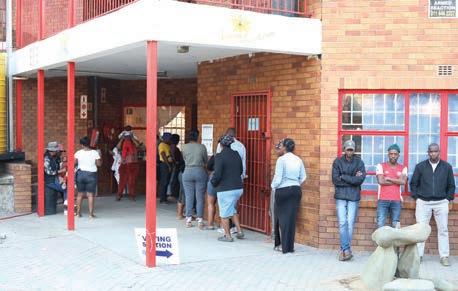

can act as a guide for elected leaders and councillors, practitioners and policymakers in local government, inspiring the development of workable solutions municipalities can adopt.
For citizens and communities, this edition will also inform communities and citizens about the work that has been done and ongoing initiatives to ensure the sector ful ls its constitutional obligations and citizens’ expectations.
Efforts to entrench democracy and improve the quality of life for everyone continue.
30 Year Review Report of South Africa’s Democracy 1994–2024



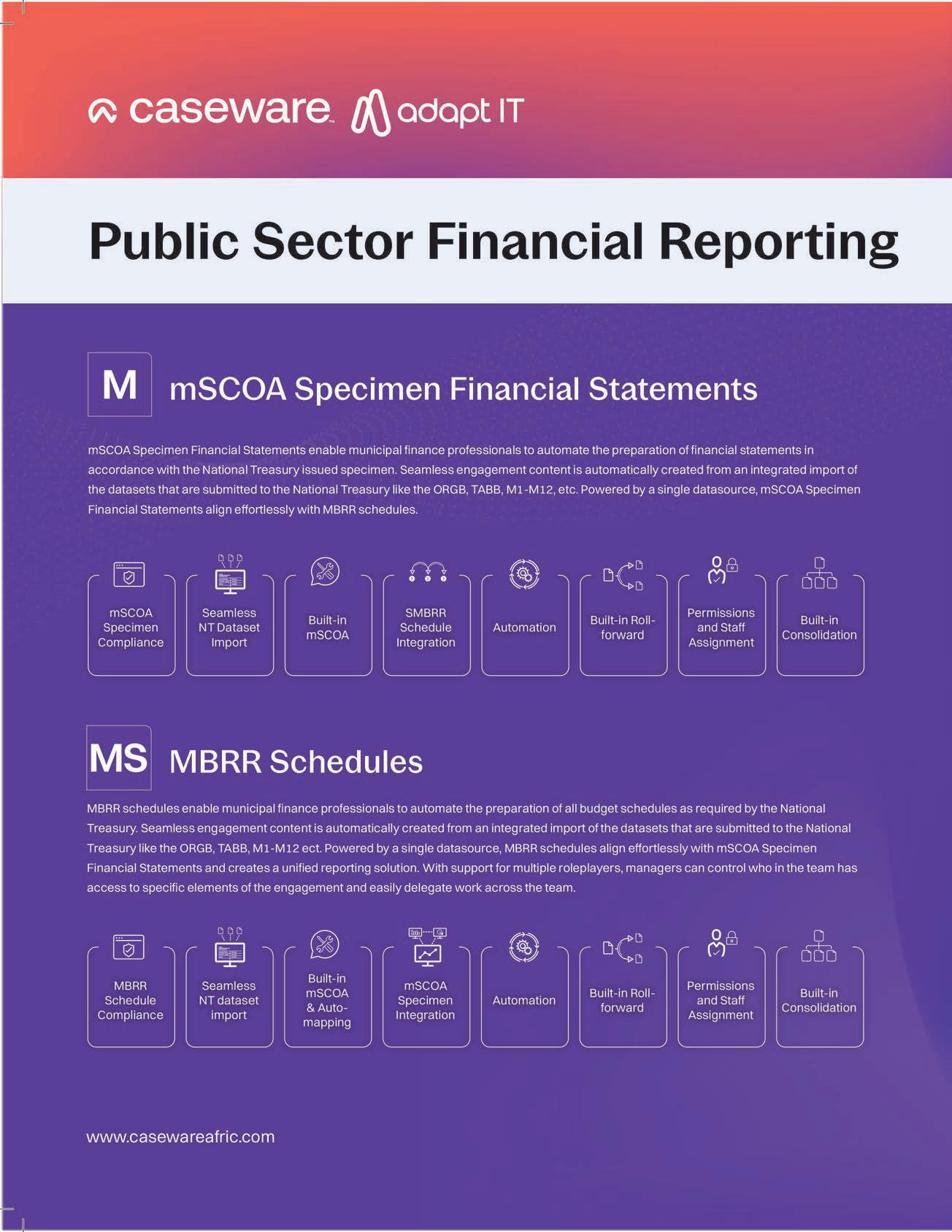


These are the most important Sustainable Development Goals for South Africa’s youth
Twelve years ago, 17 critical goals aimed at radically improving the lives of people and the planet by 2030 were identified and defined at the United Nations (UN) Conference on Sustainable Development in Rio de Janeiro. The objective was to produce a set of universal goals – known today as the UN Sustainable Development Goals (SDGs) – that meet the urgent environmental, political and economic challenges facing our world.
With less than five and a half years to 2030, it is critical to assess the progress made and, more importantly, the critical action points that still need to be taken. Achievement of the 17 SDGs largely depends on the participation of all demographic segments of society with youth playing a critical role. As tomorrow’s leaders, young people are often most affected by the choices and actions of today’s decision- and policy-makers, therefore, their involvement is a necessity.
Dion Shango, PwC Africa CEO, says: “The engagement and contribution of South Africa’s youth is essential to the progress we make in achieving the UN SDGs as youth bring new vitality, inventive ideas and fresh perspectives to the table. Their digital nativity gives them the skills to navigate the complexity of today’s world and devise innovative solutions for the problems of tomorrow.”
Of the 17 SDGs, South Africa’s youth are most concerned about clean water and sanitation, quality education, good health and wellbeing, zero hunger, peace, justice and strong institutions These are the latest findings from PwC’s 2024 Global Youth Outlook survey on the significance and future of the SDGs.
Consistent with the global results, South African youth believe that government and business can do more to make an impact – 60 per cent of respondents answered “no” when asked whether government was doing enough to help our people and the planet while 51 per cent identified nongovernmental organisations and 44 per cent identified the community sector as doing enough to respond to these needs.
A potential reason for critical views of government in democratic countries appears to be the lack of youth representation in decision-making roles: only 2.6 per cent of parliamentarians worldwide are under the age of 30, despite this demographic comprising half of the global population.
A roundup of news and significant perspectives impacting the global conversations around leadership, local government policy matters and our sustainable development goals


Gap Infrastructure Corporation (GIC), South Africa’s largest social infrastructure developer, has successfully raised R616-million in private investment to accelerate the country’s social and public infrastructure development.
Roelof van den Berg, CEO of GIC, says the achievement signifies a pivotal step forward in the company’s ambitious plans to tackle public infrastructure challenges while supporting the government’s efforts to close the infrastructure gap
An investment of between R4.8-trillion and R6.2-trillion is required to meet the country’s Sustainable Development Goals by 2030, particularly targeting transport, water and sanitation and education.

The Union of Cities and Communes of Côte d’Ivoire (UVICOCI) celebrated its 41st anniversary earlier this year with the election of a new president. Amadou Koné, mayor of Bouaké, becomes the seventh president of the umbrella association of mayors of Côte d’Ivoire. His priorities as president of UVICOCI include promoting decentralisation, improving municipal infrastructure and strengthening the ability of local governments to meet the needs of their populations.
Established on 6 July 1983, UVICOCI’s role is to support the communalisation policy, which aims to promote the effective transfer of powers and related resources between the state and local authorities.
World leaders have adopted the “Pact for the Future,” a comprehensive agreement aimed at transforming global governance and addressing modern challenges. The pact includes the Global Digital Compact, the first global framework for digital co-operation, and a Declaration on Future Generations. It focuses on areas such as peace and security, sustainable development, climate change, human rights and youth empowerment. Key reforms include improving the UN Security Council’s representation, advancing nuclear disarmament and addressing climate challenges. The pact aims to ensure the international system can better serve a changing world.
The General Assembly elected 18 members to the Human Rights Council for the 2025–2027 term, including countries such as Benin, Cyprus and Kenya. These new members will begin their three-year terms in January 2025, replacing outgoing members such as Argentina and India.
The assembly also adopted a resolution regarding United Nations expense assessments, addressing requests under Article 19 for voting rights reinstatement. Afghanistan expressed disappointment over the denial of its voting rights due to its inability to meet financial obligations, citing the Taliban’s control as a contributing factor. Additionally, discussions on antimicrobial resistance emphasised global co-operation, technology transfer and eliminating coercive measures that hinder developing countries’ health efforts.
With more than 600 million people across Africa lacking access to electricity, the International Energy Agency estimates that Africa will need to double its electricity generation capacity by 2040 to meet growing demand
The African continent has been identi ed as a prime source for renewable energy exports to regions seeking to reduce reliance on fossil fuels and meet net-zero targets.
Most development banks, bilateral aid, export credit agencies and development nance institutions have a clear mandate to facilitate the energy transition. Many offer preferable terms to projects that help achieve net-zero targets. Additionally, numerous climate investment funds and venture capital funds are dedicated to green energy investments, including throughout the development stage.
From its international soft launch at COP28 UAE in Dubai last December, the Road to Namibia campaign, in support of the Global African Hydrogen Summit, has evolved into a movement fuelling Africa’s green industrial revolution.
Following nine months on the road across the world advocating, lobbying and raising awareness, the Road to Namibia campaign rolled into its nal destination (Windhoek) in early September to host the Global African Hydrogen Summit, themed “From Ambition to Action: Fuelling Africa’s Green Industrial Revolution”. At the heart of the Global African Hydrogen Summit is the mission to drive critical investments and nancing for bankable green energy projects across Africa.
Guest of honour Her Excellency Netumbo Nandi-Ndaitwah, vice president, Republic of Namibia, greeted over 1 000 attendees
at the opening ceremony of the summit, saying: “Namibia is honoured to host the Global African Hydrogen Summit. It is encouraging to witness such a diverse gathering of brilliant minds from around the world who have convened here to help us curate rich conversations on these vital topics. Namibia offers a rich and welcoming environment well suited to host an impactful green industrialisation eco-system.”
The summit’s sectoral patron, Honourable Tom Alweendo, Minister of Mines and Energy, Republic of Namibia, had earlier remarked: “The Global African Hydrogen Summit will be the rst platform of its kind to be leveraged by African governments, investors, nanciers, scholars and the public to unlock additional opportunities for our continent and its partners. It will also provide a platform for the global players in the hydrogen value chain to showcase their projects, plans and technologies to the African continent.”
The Global African Hydrogen Summit witnessed 10 memorandum of understanding (MoU) announcements, partnership declarations and deal signings. •€25-million in grants from the European Union to support the Namibian Green Industrialisation Agenda. The initiative, which includes commitments from Germany and the Netherlands, will be channelled via the SDG Namibia One nancing vehicle for green hydrogen investment in Namibia, including technical assistance to support long-term energy planning,
At the heart of the Global African Hydrogen Summit is the mission to drive critical investments and financing for bankable green energy projects across Africa.
renewable energy generation and grid integration in collaboration with key Namibian stakeholders, including the Namibian Green Hydrogen Programme (NGH2P) and Namibian Standards Institution (NSI).
•Zhero announced the launch of a green ammonia gigawatt-scale project in Namibia. With co-developers Envision Energy it aims to produce 500 000 tons annually from 2029.
•GreenGo Energy signed an MoU with local Namibian developer InnoSun Energy Holdings to co-develop solar and wind projects dedicated to green hydrogen production at scale.
•GreenGo Energy announced the signing of a MoU with local Namibian iron mining company Lodestone. This collaboration will explore innovative solutions to integrate green hydrogen into the steel production process.
•The Namibian cabinet approved the signing of a MoU on the co-operation on renewable energy, clean energy and hydrogen between Namibia and the United States of America.
•The International Energy Agency will collaborate with the Ministry of Mines and Energy of Namibia and NGH2P on renewable energy opportunities for Namibia.
•Africa Practice and Environmental Defense Fund forge strategic partnerships to advance climate action in Africa.
•Green Maritime Corridors announcement to be launched at COP29 in Azerbaijan.
•Green Hydrogen Organisation and UN High-Level Climate Champions commit to biannual dialogue with CSOs.
•The Green Hydrogen Business Alliance launches “Localising Green Industries in Namibia”.
The summit unlocked the potential of the hydrogen opportunity in Africa and harnessed its projected impact on achieving a sustainable and equitable energy transition globally.
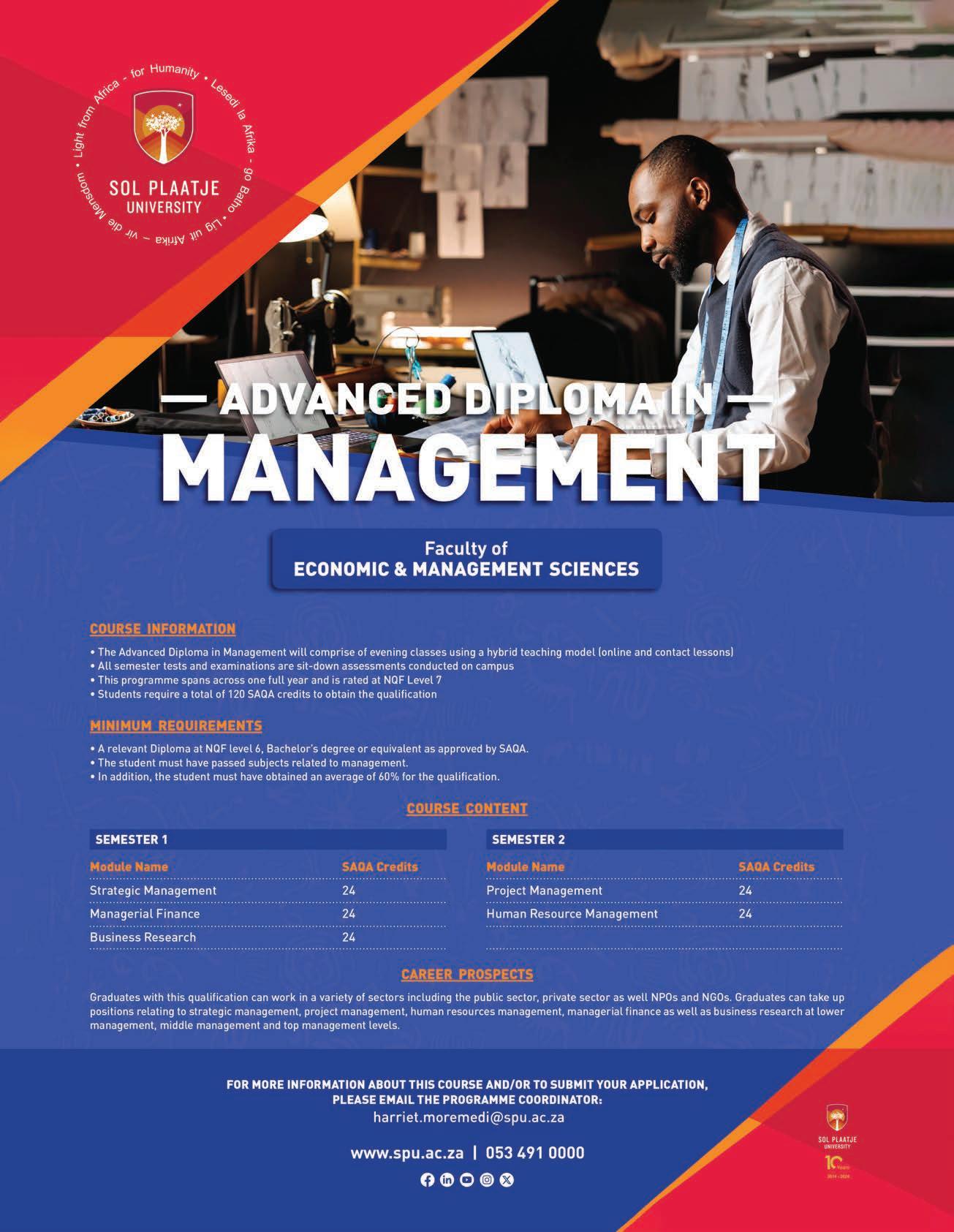
14 30 years on – the evolution of local government.
18 Forget politics – these are the basics needed to resuscitate economic growth.
20 Youth development progresses at a snail’s pace.
24 The land issue: Managing municipal land; Releasing municipal land for affordable housing; Apartheid spatial planning.
34 Is Mzansi ready for e-taxis?; Road safety.
37 Technology: The city of the future; SA moves to the cloud.
As South Africa grapples with a worsening water crisis, the government is seeking innovative solutions to fund and develop essential water infrastructure. A key step in this direction is the establishment of the South African National Water Resources Infrastructure Agency (the Agency), as outlined in the recently approved Bill.
The Agency’s mandate: the Agency will be a public entity responsible for acquiring, funding, maintaining and operating national water resources infrastructure. Its primary goal is to address the social and economic development needs of current and future water users. To achieve this, the Agency will have the power to raise commercial and development finance, thus reducing reliance on government funding.
KEY PROVISIONS OF THE BILL
• Establishment: the Agency will be a Schedule 2 public entity incorporated under both the Public Finance Management Act and the Companies Act.
• Governance: the State will be the sole shareholder with the Agency’s powers and functions exercised under the Minister of Water and Sanitation.
• Funding: the Agency will have the authority to raise commercial and development finance, enabling it to fund infrastructure projects without relying solely on government funds.

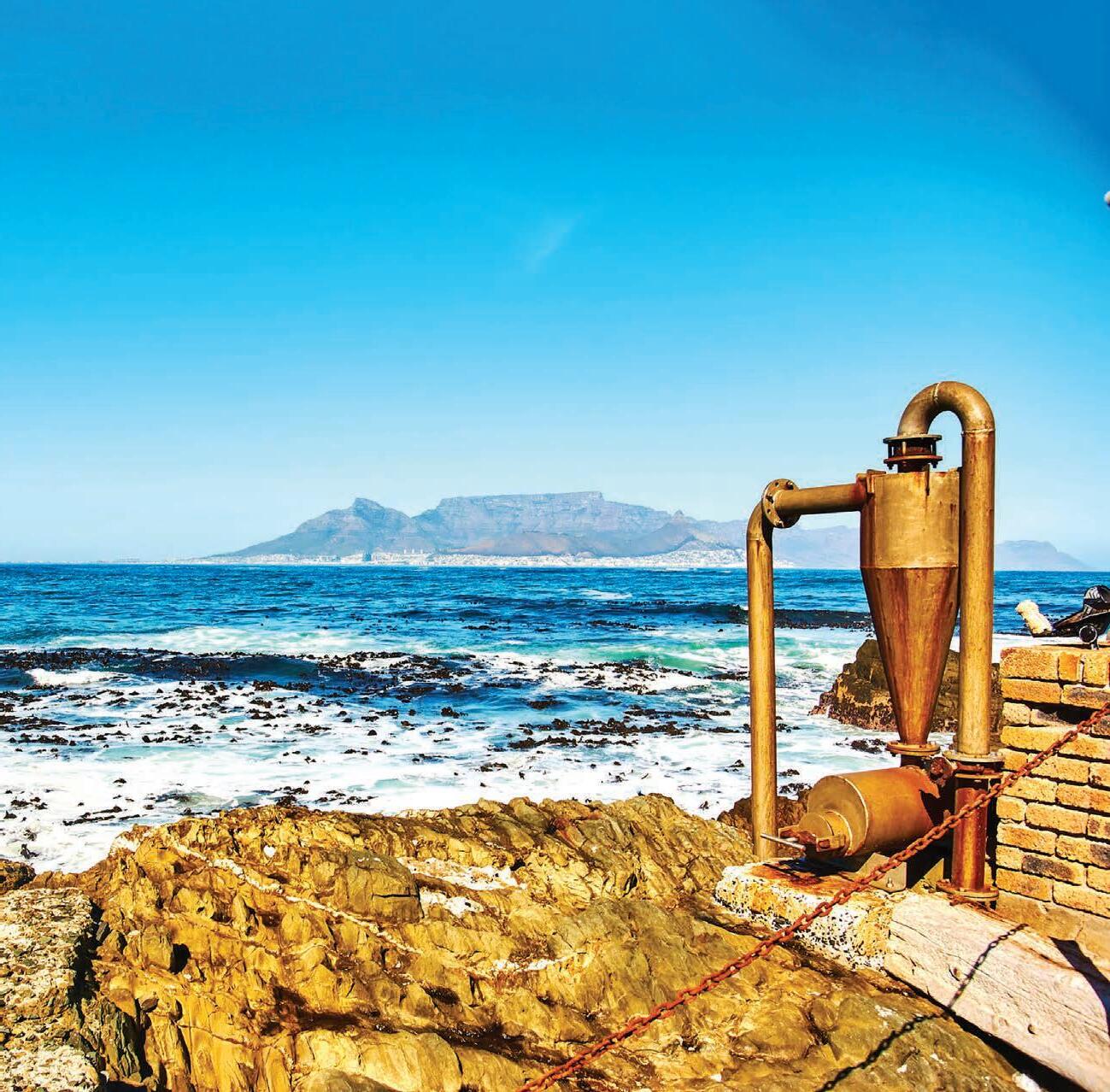
• Infrastructure transfer: Chapter 6 of the Bill proposes transferring national water resources infrastructure to the Agency and disestablishing the Trans-Caledon Tunnel Authority. This is intended to provide the Agency with a strong asset base and attract private sector investment.
The creation of the Agency represents a significant step towards addressing South Africa’s water crisis. By leveraging private sector investment and innovative financing mechanisms, the Agency can accelerate the development of essential water infrastructure. This will not only improve water security, but also contribute to economic growth and social development. However, the success of the Agency will depend on effective governance, transparent decision-making and the ability to attract sufficient funding. It will also be crucial to ensure that the Agency’s activities align with broader national water resource management strategies.
While municipalities continue to be at the heart of building inclusive and sustainable communities, the battle to live up to this ideal has often been uphill, writes BUSANI MOYO

South Africa entered a new era in 1994. Tired from more than 300 years of racial segregation, South Africans heaved a sigh of relief, knowing that services across the board would now be available to all citizens in a fair, equitable and just manner. In the new dispensation, the local government represented a central pillar, not just for service delivery, but also for democratic participation.
Thirty years later, everyone will agree that the battle to live up to this ideal has often been uphill. While municipalities continue to be at the heart of building inclusive and sustainable communities, there is no running away from the fact that they face signi cant challenges – ranging from service delivery protests to nancial mismanagement, corruption and political instability in the hands of coalition governments.
As the country commemorates 30 years of democracy, we pause, take stock and ask crucial questions. How has local government in South Africa evolved? What
are some of the key milestones, challenges and successes witnessed?
When we re ect on the historical context, post-apartheid reforms and key milestones, we can better understand the successes achieved and the challenges that still exist. As we look back at 30 years of local government, we should not just consider where we are today, but also where we need to go to realise the full potential of municipalities as engines of development and community empowerment.
Understanding the prevailing local government landscape would be impossible without rst looking back to its origins under apartheid. It’s hardly news to anyone that the local governance system pre-1994 was deeply fragmented, designed to entrench the political and economic dominance of the white minority while excluding black South Africans from meaningful participation.
Professor Sam Koma is the director of the School of Economics and Management at the University of Limpopop’s Faculty of Management and Law. He is also the author of a research paper, “The Evolution of Developmental Local Government in South Africa: Issues, Trends and Options”, published in the Journal of US-China Public Administration. Professor Koma comments on a wide range of issues relating to the last three decades of local government in South Africa.
“Historically, the local government system in South Africa has been a site of struggle manifesting through resistance to segregation, in ux control and exclusion of the majority of black people from accessing basic municipal services and democratisation,” says Professor Koma. He adds: “For example, the Group Areas Act of 1966, a key piece of apartheid legislation, instituted strict residential segregation. Thus, calls for spatial justice, spatial integration and spatial transformation should be viewed in this historical context.”
Lungelwa Kaywood is an experienced professional in local government, holding a PhD in law and development. With over 20 years of experience in the public sector, she has held key roles, including deputy city manager of corporate services at the City of uMhlathuze and senior researcher at the South African Local Government

Association (SALGA), as well as positions within provincial treasuries. Kaywood says: “The history of local government in South Africa can be traced back to 1652 when Dutch colonists arrived at the Cape of Good Hope.” She breaks down the periods marking this history:
• Dutch colonial rule (1652–1795): introduced basic local governance structures such as the Council of Policy, Heemraden and Landdrosts. Several municipalities were established during this time of the Dutch East India Company, namely Stellenbosch in 1679, Drakenstein in 1687, Swellendam in 1745 and Graaff-Reinet in 1786.
• British colonial rule (1795–1910): brought changes like the Cape Municipal Ordinance 1836 and the establishment of more formal municipal structures.
• Union of South Africa was formed (1910–1948): local government regulated by provincial councils under the South Africa Act of 1909.
• Apartheid era (1948–1993): racially segregated local government system with separate structures for different racial groups. The apartheid government formalised racial segregation through legislation that profoundly impacted local governance, access to services and the quality and quantity of service delivery to the black population.
• Transition to democracy (1993 onwards): the apartheid local government system was overhauled and a new democratic local government system was introduced.
The local government system prevailing in South Africa today represents a system that rose from the ashes of a racially strati ed arrangement, which did not just perpetuate inequality, but also sparked the resistance that laid the groundwork for local governance in the post-apartheid era. It is on this basis that Professor Koma argues that “the system of local government in South Africa has been a site of struggle”. In 1994, when the new democratically elected government of Nelson Mandela took over, there was no doubt that if local government was to live up to the expectations of the new country, it had to change drastically. Acting SALGA CEO
Lance Joel says the priority during the transition was to enact enabling legislation. He refers to the Local Government Transition Act (LGTA) of 1993 and the 1996 signing of the new constitution by Mandela. Joel indicates that the main change the act brought about was to create a local government that was not merely “an extension of the national government”.
Professor Koma agrees with Joel: “The enactment of the Local Government Transition Act of 1993 was a crucial step aimed at deracialising the local government system in the country. This legislative reform led to the nal phase of local government transformation in 2000.”
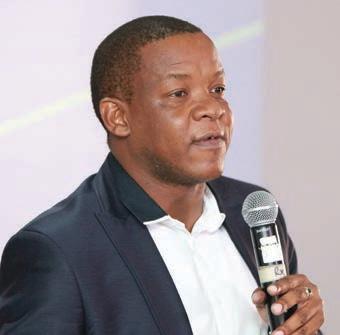
In the noise surrounding poor service delivery, it is easy to overlook the achievements attained by local government in the last 30 years. In this regard, Professor Koma says the main achievement of the transition from apartheid to majority rule “was the uni cation of the formerly white and black local administrations tasked to ful l constitutional obligations of ensuring that local government assumes a developmental role and provides democratic and accountable government to local communities”.
To get an idea of the achievements of local government in the last three decades, it is crucial to revisit the state of affairs
Auditor-General’s Municipal Finance Management Act Audit

in 1994. According to the South African Government Communication Services, “In 1994, 12 million people had no access to safe drinking water, 17 million lived below the poverty line while 21 million had no adequate sanitation. About 2 million were subjected to using the bucket system, a stark violation of the right to dignity and unhygienic. The urban housing backlog in 1990 was conservatively estimated at 1.3 million units. Including hostels and rural areas, the backlog rose to approximately three million units.”
The same source notes that the situation is quite different today because the last 30 years have seen local governments addressing some of the challenges inherited in 1994, uplifting the material condition of South Africans. It refers to the numbers: “In 2022, approximately 66.3 per cent of households in the country had their refuse removed by a local authority once a week, as opposed to 52 per cent in 1996.” The Government Communication Services adds that through the Reconstruction and Development Programme (RDP), “about 13.7 million people have been provided with homes through various social housing programmes from 1994 to 2022. In 2022, 83.2 per cent of households had access to improved sanitation services, while those using electricity as the main source of energy for lighting increased from 58.1 per cent in 1996 to 94.7 per cent in 2022”.
As we look back at 30 years of local government, we should not just consider where we are today, but also where we need to go to realise the full potential of municipalities as engines of development and community empowerment.
No one can argue against the proposition that strides have been made in the democratisation of local government in the last three decades. The same applies to the reality that signi cant challenges plague the system. For example, it doesn’t take very long after landing in South Africa to see piles of garbage in places like the Johannesburg CBD, sprawling slums or potholes on some roads, indicating that maybe things have not gone entirely according to plan.
Switch on to any of South Africa’s news stations, and you will likely learn about service delivery protests, a corruption scandal and areas without power or water for days. Reports from the Auditor-General frequently expose poor governance in numerous municipalities. Add to this the political instability – often exacerbated by factionalism, coalition politics and inadequate leadership – and you will understand why public trust has been eroded.
These challenges are more than just a gment of the imagination of those who want to paint the wrong story about South Africa. Professor Koma agrees: “Empirical evidence points out that communities experience poor quality and unreliable delivery of services in many municipalities, despite the high cost of such services. Institutionally, many municipalities continue to underperform in meeting the basic needs of local communities, for example, the electricity crisis plus the water crisis are two cases to af rm this point.”
What do the next 30 years of local government look like? Professor Koma says: “Many municipalities are engulfed with endemic governance challenges; the Auditor-General’s Municipal Finance Management Act Audit Outcomes attest to this point. Compounding this situation is urbanisation, which is not in keeping with the institutional capacity of municipalities to adequately respond to this challenge in terms of extending access to basic services, ensuring increased maintenance of municipal infrastructure and implementation of new infrastructure, among others.”
Lungelo Kaywood is one of the three authors of the book, The Journey to Transform Local Government. She charts the key milestones in South Africa’s history of local government:
• 1836: Cape Municipal Ordinance enacted, providing a framework for municipal regulations.
• 1910: formation of Union of South Africa, placing local government under provincial control.
• 1950s–1960s: Group Areas Act and other apartheid legislation enforcing racial segregation in local government.
• 1982: Black Local Authorities Act establishing separate local authorities for black townships.
• 1993: interim Constitution providing for nonracial local government.
• 1996: new Constitution enshrining developmental local government.
• 1998: white paper on local government (the mini Constitution) and several laws after that are introduced.
• 2000: first democratic local government elections are held.
• 2004: several legislative reforms, such as the Municipal Finance Management Act, and regulations are introduced as guidelines for assisting the new administration in navigating the system are introduced.
• 2009 onwards: introduction of LGTAS, Siyenza Manje of “Back to Basics” strategy, among other strategies, such as the District Development Model.
Kaywood adds: “The overall trajectory will likely involve ongoing efforts to strengthen local government capacity, improve service delivery and deepen local democracy in line with constitutional mandates.” She provides a list of what will need to be done to improve things at local government level:
• Infusing a public value approach into the discourse on local government.
• Revisiting the funding model for local government.

• Legislating the coalition governance at a local government level for a more stable governance.
• Further addressing historical inequalities and service delivery backlogs.
• Enhancing public participation, transparency and accountability.
• Improving nancial management, expanding and protecting revenue sources.
• Improving the investment in asset management and spending adequately on repairs, maintenance and refurbishments.
• Developing capacity and professionalising local government administration.
• Balancing centralised policy direction with local autonomy.
• Leveraging technology for improved service delivery and citizen engagement.
• Enhancing intergovernmental co-ordination through models like the District Development Model.
• Further demarcation or redetermination of boundaries, based on various factors such as capacity.
Professor Koma believes that “if the national government does not urgently resolve the review of the Local Government Funding Framework, municipalities will remain nancially and institutionally incapable of addressing the evolving needs and interests of local communities”.
In conclusion, he says: “The sphere of local government will continue to underperform unless drastic measures are taken to remedy this situation through improving the capability of the political leadership and senior executive management of municipalities. Local government is bound to ounder if the wrong people are appointed into the right positions.”

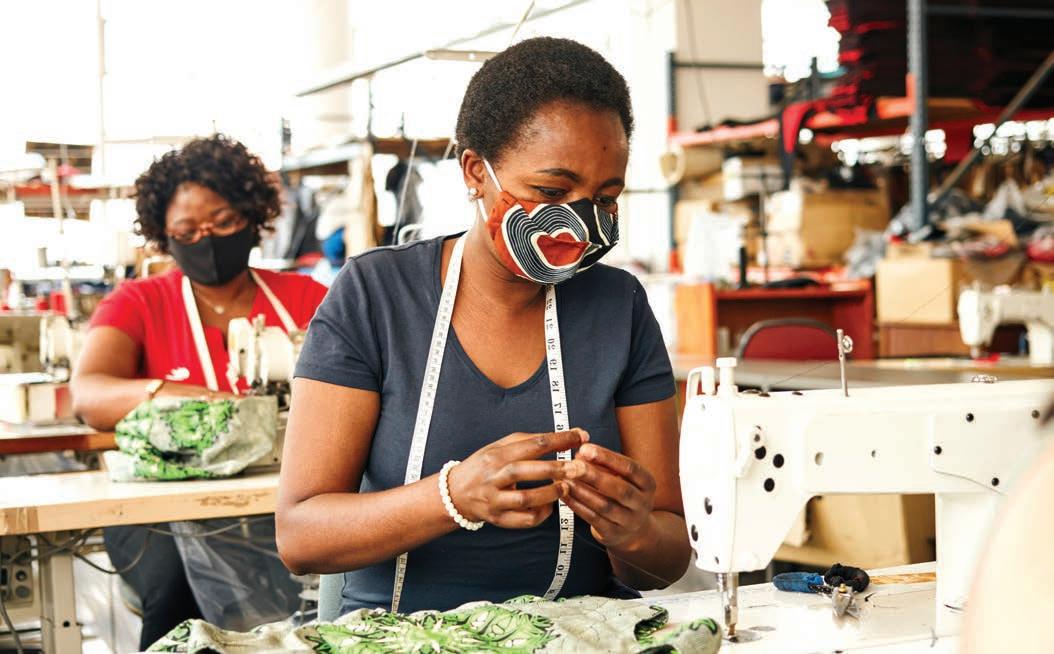
DR ZIZAMELE CEBEKHULU-MAKHAZA, chairperson of PGC and the Popcru Trust, shares that even as political parties jostle for power, the reality is that no matter who leads us forward, there is only one real solution to re-energising socioeconomic growth and development: industrialisation
Industrialisation hinges on making informed, pragmatic energy decisions and sustainable infrastructure development. These are the fundamentals ultimately needed to stimulate investment, grow businesses and accelerate employment.
But instead, by neglecting these pillars, South Africa’s economy has faltered and stagnated for decades, entrenching poverty, inequality and unemployment.
So, as we look ahead to the next ve years, we must not allow ourselves to become distracted by politics – these are the three real metrics that should be used to evaluate the seventh administration’s performance.
China stands out as a case in point demonstrating the impact of industrialisation. Now a global giant, the Chinese economy was likewise stagnant until the late 1970s when it implemented new economic reforms while investing in industrialisation, infrastructure and education. In response, this saw an exponential increase in productivity and output, supporting local manufacturing while driving export growth.
The results were remarkable. Experts calculate that over the next 40 years, its gross domestic product effectively doubled
every eight years. By the late 1990s, per capita income had nearly quadrupled and by 2020, some 800 million of its people had been freed from poverty.
Today, in terms of purchasing power parity exchange rates, or how far consumers’ money stretches, China’s economy is more than 20 per cent larger than even the United States of America.
Industrialisation generates jobs, income, wealth and shared prosperity. In other words, industrialisation is the key ingredient needed to grow South Africa’s “pie”, or economy, at a rate fast enough to satisfy our developmental needs.

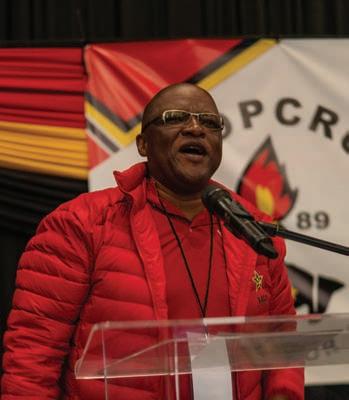



To fuel industrialisation, however, we need a reliable energy supply, which is where current policies seem to be faltering. Energy infrastructure is vital to end load shedding and provide suf cient capacity to power economic growth. But, while the need is urgent, solar energy is a quick x for households and small businesses, not energy-intensive industries.
Solar power, despite its environmental bene ts, simply cannot meet the demands of heavy machinery and large-scale manufacturing processes. As such, we cannot afford to continue overemphasising solar power. A diversi ed energy mix is crucial, including coal and nuclear power in addition to renewable sources.
Coal power is a cornerstone of our current energy framework. Not only is coal an abundant and relatively inexpensive resource, but coal plants are also responsible for many thousands of jobs and livelihoods. The idea of a sudden shift away from coal is therefore impractical and could have devastating impacts on workers and their families. Instead, a gradual transition that includes comprehensive support for workers and communities reliant on the coal industry is needed.
Although concerns about corruption and safety have seen nuclear energy become sidelined, it must also be reconsidered as a viable option to improve our baseload supply. With the construction of just two nuclear plants alone, South Africa could potentially power the entire country, signi cantly reducing the strain on our national grid.
Corruption is certainly an issue that must be addressed head-on. But while the risks associated with such megaprojects are unfortunately very real, these must be managed with strict oversight and governance rather than throwing the baby out with the bath water.
Industrialisation is the key ingredient needed to grow South Africa’s “pie”, or economy, at a rate fast enough to satisfy our developmental needs.
Additionally, there must be strict agreements in place to ensure that nuclear infrastructure is eventually transferred to local control after a set number of years and that the necessary processes are followed to prevent past mistakes such as receiving unreadable instructions in German.

Our energy infrastructure is not the only infrastructure that has suffered underinvestment. Local infrastructure generally has become dilapidated, presenting a major obstacle to business. So, our focus cannot be limited to rolling out new infrastructure. Maintenance must also be prioritised for a more sustainable approach to infrastructure.
Poor maintenance is glaring in rural areas where new electricity and water systems have been installed, but lack of upkeep has quickly rendered these services useless. Basic maintenance –xing potholes, maintaining water pipes and ensuring consistent power supply – is crucial to restoring public con dence, attracting the right investors and encouraging economic activity.
Reviving our railways is also critical. The current volume of traf c and trucks on our roads is unsustainable, causing severe congestion in urban centres and accelerating road decay across the country. An ef cient railway system would alleviate the pressure placed on our roads, reduce transport costs and enhance the overall ef ciency of logistics systems for the smoother transportation of goods.
Likewise, amid soaring costs of living, the development of ef cient public transportation systems is another area where government intervention is required urgently. Reliable and affordable public transport would signi cantly reduce the burden of transport costs on workers and households.
Ultimately, dreams of smart cities and a future driven by electric vehicles are admirable. But they remain simply dreams without the foundational infrastructure and energy in place.
Creating jobs and lifting our people out of poverty demands a back-to-basics approach. The recent election results may have shaped our political landscape and narrative, but the real work will lie in getting these basics right if the government is to steer South Africa successfully towards a brighter future.
JEFF MKHWANAZI, executive director of the Southern African Association of Youth Clubs, unpacks the critical need for sustainable and solution-oriented approaches to youth development to secure a brighter future for our nation

This year marks a momentous milestone for South Africa as we commemorate 30 years of democracy. Thirty years since the rst democratic election faced with much hope and aspiration. It was seen as a turning point in ensuring a future where we overcome the struggles of inequality, poverty, limited resources and access to education. While we have made great strides in tackling some of the issues facing the country, can we really claim success, particularly when it comes to the current situation facing our youth?
Three decades later, we are still confronted with a colossal socioeconomic challenge in creating an environment that re ects youth progress and development on a large and sustainable scale. We have retrogressed in some aspects, with young people in an even more dire position when it comes to poor employment prospects, poverty, high levels of crime, limited access to education, sexual abuse and numerous social ills.
There are also the “less visible” threats to the health and wellness of our young people. The topic of mental health, for instance, is still stigmatised and not acknowledged for the impact it has on youth health, wellbeing and their ability to navigate life daily. Climate change is another topic that may seem irrelevant or far removed from communities besieged by fundamental issues such as poverty and hunger. However, it is these most vulnerable communities that experience the worst impact of climate-related disasters such as ash oods and extreme weather conditions.
Considering the immense scale of the problems faced by the youth, the situation seems overwhelming. But the reality is that now is the best time to mobilise society for positive change – the adversities we observe now are only going to get worse unless we take prompt and impactful action.
Now is the best time to mobilise society for positive change – the adversities we observe now are only going to get worse unless we take prompt and impactful action.
Throughout South Africa, more than 145 000 quality work experiences have been created for the youth in the past five years. To date, the YES initiative has injected R7.9-billion into the economy via youth salaries, without government funding.
Source: YES
Government agendas must prioritise youth development. Given that the entire future of the nation rests in the hands of our youth, this is the most logical approach. Such prioritisation includes government-driven skills development, funding, entry-level job creation, increased internship opportunities (such as government-funded initiatives), access to information and technology, improved education standards and community-centric political decision-making.
Merely treating the symptoms is not a long-term situation – the emphasis needs to be on strategic solutions that address the root of problems. For example, a heightened focus needs to be on early childhood development. According to a 2021 Progress in International Reading Literacy Study report, 81 per cent of Grade 4 learners in South Africa cannot read for meaning. This should be treated as an education crisis and steps taken to address the situation as a matter of urgency. Furthermore, access to high-quality education at an early stage can positively contribute to reduced levels of poverty, crime, drug use and so forth later in life.

Jeff Mkhwanazi
Access to quality healthcare and health education can result in decreased numbers of unwanted teenage pregnancies and the
spread of sexually transmitted diseases among the youth. Healthcare education and support can also help young people struggling with mental health issues and substance abuse. Reducing the number of teenage deaths through suicide and social ills is an absolute priority.
If we are realistic, it would take the government a considerable amount of planning, time and resources to create the social transformation required to make a tangible change in the near future. Catalysing socioeconomic development requires the involvement of broader society, including the private sector and ordinary citizens. People can get involved through volunteering or offering knowledge and development through mentorship programmes. The private sector is also pivotal in offering palpable solutions, such as nancial contributions to youth initiatives or implementing organisational youth development projects. More powerful still are collaborative efforts between the public and private sectors, aimed at providing practical and sustainable outcomes for the youth.
Information and communication technology skills are essential for the next
workforce generation and we need to escalate the delivery of accessible tech-based upskilling programmes. With the rapid expansion of arti cial intelligence and automation, a reduced number of human-driven entry-level jobs will be available. We therefore need to increase the digital literacy capabilities of young people to survive in an increasingly tech-driven socioeconomic environment. The private sector can help provide infrastructural development, training and nancial support to speed up digital transformation.
On the other hand, we have skilled youth struggling to enter the job market due to lack of experience. There must be mechanisms in place to bridge this gap. For instance, the nonpro t DigiLink tech-focused Work Integrated Learning programme connects young entry-level digital talent with potential employers. Candidates are supervised and guided to support the employers’ existing digital services staff, thereby gaining workplace knowledge and learning from experienced staff, which increases their chances of employment, while the employer augments and supplements its digital workforce with young talent. The initiative is driven by Harambee Youth Employment
As part of its contribution to addressing South Africa’s burgeoning unemployment crisis, Nedbank’s Youth Employment Service (YES) cohort for 2024, sees close to 3 500 YES Youth embark on work experience opportunities at Nedbank and its implementation partners. These opportunities provide the youth with their first job, on-the-job training in jobs for the future and personal development and mentorship around the soft skills needed to thrive in the modern workplace.
“The Youth Employment Service is an important part of Nedbank’s overall young talent strategy. It is underscored by our commitment to be part of the solution to South Africa’s stubborn youth unemployment rates, and create hope
for our young people,” says Deb Fuller, group executive for human resources at Nedbank.
“The overarching benefit of this programme is poverty eradication and job creation for young people who have never worked. The lack of work experience can be a great barrier to building a successful career,” adds Fuller.
“We aren’t short on great talent in South Africa – we are short on job opportunities. We couldn’t be prouder of the talent our YES Youth Programme has unearthed and the tangible and material impact these work experience opportunities provide to the young people enrolled and their communities.”
In particular, the goal is to ensure that YES candidates gain access to
Accelerator, a social enterprise working with public and private sector partners to nd solutions to youth unemployment. Another collaborative project is the Youth Employment Service (YES). YES is an impact-driven private-sector-led initiative that receives no government funding. The programme works with various business organisations to provide 12-month practical work experiences for young people who are trained to become skilled professionals, managers and entrepreneurs who will, in turn, contribute to the future economic growth of the country.
Despite the many challenges, a wealth of potential and hope exists. We are still in a position to turn the tide towards positive outcomes. By working together, we can change the outlook of the future. We can help young people to help themselves by supporting youth entrepreneurship and social entrepreneurship aimed at changing lives and communities while doing good for society.
Let’s ignite a mindset of optimism and employ renewed commitment to creating a better future for our young people. Let’s support their pioneering spirit through solution-driven approaches that will bene t the youth and society. We have the power to change the future – let’s make it happen.
competitive skills and experience in areas where there is a paucity of available skills, including renewable energy, environmental conservation, sustainability, agri-processing and other high-growth and impactful sectors. These sectors also align with Nedbank’s strategic sustainability agenda.
“YES tracks post-programme employment of all YES Youth alumni and Nedbank has been able to report 36 per cent post-programme employment of our alumni. This figure far exceeds the YES-guided 2.5 per cent absorption target,” Fuller says.
YES CEO Ravi Naidoo says the initiative is the highest impact private sector youth employment programme in South Africa, working with more than 1 700 businesses to tackle the country’s youth unemployment crisis.


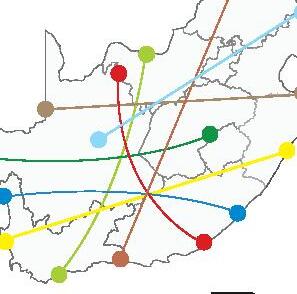


In the interest of intensifying stakeholder understanding of demarcation processes (Ward Delimitation process), The Municipal Demarcation Board (MDB) conducted the education and awareness campaign from July to October 2024. As such, it is envisaged that once stakeholders comprehend the intention of the process, they will be able to actively participate. The MDB delimits wards every five years in preparation for the local government elections (LGE) in line with the Municipal Structures Act 117 0f 1998, schedule 1 as amended (MSA). Members of the public are encouraged to actively participate in the process and lookout for updates on: www.demarcation.org.za
In February 2024, the MDB completed the municipal boundary re-determination process.
As highlighted in Circular 3 of 2024, the MDB deferred several municipal boundary redetermination proposals pending further research and stakeholder engagements.
The MDB will be continuing with the research and stakeholder engagement process between July 2024 and end of March 2025. Thereafter, if the MDB is of
a view that municipal boundaries should be re-determined, the municipal boundary re-determination process will be conducted between April 2025 for completion by September 2025. It should be noted that, the ward delimitation process for the municipalities affected by these municipal boundary redetermination proposals will be conducted on completion of this process. In this regard,
the Ward Delimitation process for the deferred cases is tentatively planned to take place between October and December 2025. However, all this is dependent on the outcome of the municipal boundary re-determination process, which could be completed earlier than September 2025. The MDB will keep all affected stakeholders updated on the progress regarding the deferred cases and the subsequent ward delimitation process.
Deferred Municipal Redeterminations Proposals, which require further research, public consultation, and / or stakeholder engagements are as follows:
DESCRIPTION
EC DEM6580
EC DEM6599
Proposed redetermination of the municipal boundaries of Raymond Mhlaba Local Municipality (EC129), Amathole District Municipality (DC12), Blue Crane Route Local Municipality (EC102) and Sarah Baartman District Municipality (DC10) by excluding Bedford town community from the municipal areas of Raymond Mhlaba Local Municipality (EC129) and Amathole Local Municipality (DC12), and by including it into the municipal areas of Blue Crane Route Local Municipality (EC102) and Sarah Baartman District Municipality (DC10).
Proposed redetermination of the municipal boundaries of Enoch Mgijima Local Municipality (EC139) and Inxuba Yethemba Local Municipality (EC131) by excluding Hofmeyer community (portions of Wards 28 and 34) from the municipal area of Enoch Mgijima Local Municipality (EC139), and by including it into the municipal area of Inxuba Yethemba Local Municipality (EC131).
EC DEM6599
Proposed redetermination of the municipal boundaries of Enoch Mgijima Local Municipality (EC139) and Inxuba Yethemba Local Municipality (EC131) by excluding the Hofmeyer community from the municipal area of Enoch Mgijima Local Municipality (EC139), and by including it into the municipal area of Inxuba Yethemba Local Municipality (EC131).
PROVINCE DEM NO.
DESCRIPTION
FS DEM6765
FS DEM6781
Proposed redetermination of the municipal boundaries of Mangaung Metropolitan Municipality (MAN), Mohokare Local Municipality (FS163) and Xhariep District Municipality (DC16) by excluding the former Naledi towns (Dewetsdorp, Wepener and Vanstandensrus currently constituting Wards 43 and 50) from the municipal area of Mangaung Metropolitan Municipality (MAN); by excluding the broader Zastron area (Wards 1, 3, 7 and a portion of Ward 5 (including Ethelia farm) from the municipal areas of Mohokare Local Municipality (FS163) and Xhariep District Municipality (DC16), to establish a new Category B, Local Municipality in Free State.
Local Municipality (FS194) excluding the Greater Harrismith Area (Wards 1, 3, 4, 5 , 6 & 22 including towns of Kestell, Harrismith and surrounding areas, Tlholong, Intabazwe, Selahlilwe Informal Setlements, Wilgepark, Schoomplaas, Kings hill, Bergsig, Westerson, Tshiame A, B and C and Makholokweng Tribal Areas, Sterkfontein Dam, Nature Reserve and Swinburne Village) from Maluti a Phofung local Municipality, to create a new municipality.
FS DEM6782
DEM4520_5
FS DEM7502
Proposed redetermination of the municipal boundary of Maluti a Phofung Local Municipality (FS194) by excluding 29 wards of the former Qwa Qwa Homeland area (Including the former TLCs of Phuthaditjhaba and Qwa-Qwa Rural) from Maluti a Phofung Local Municipality (FS194), to create a new municipality.
Proposed redetermination of the municipal boundaries of Msunduzi Local Municipality (KZN225), Richmond Local Municipality (KZN227) and Umgungundlovu District Municipality (DC22) by amalgamating the two Local Municipalities, to establish a new Category A, Metropolitan Municipality in Umgungundlovu District Municipality (DC22) in KwaZulu Natal.
Proposed redetermination of the municipal boundaries of Makhado Local Municipality (LIM344) and Collins Chabane Local Municipality (LIM345), by excluding a portion of Bungeni traditional council area from the municipal area of Makhado Local Municipality (LIM344), and by including it into the municipal area of Collins Chabane Local Municipality (LIM345).
FS DEM7504
FS DEM7505
Proposed redetermination of the municipal boundaries of Thulamela Local Municipality (LIM343), Musina Local Municipality (LIM341) and Vhembe District Municipality (DC34) by excluding portions (following the former Mutale Local Municipality boundary) from the municipal area of Thulamela Local Municipality (LIM343) and Musina Local Municipality (LIM341), to establish a new Category B, Local Municipality in Vhembe District Municipality (DC34).
Proposed redetermination of the municipal boundaries of Makhuduthamaga Local Municipality (LIM473) and Elias Motsoaledi Local Municipality (LIM472), by excluding portions of farm KLIPSPRUIT 870 KS from the municipal area of Elias Motsoaledi Local Municipality (LIM472), and by including it into the municipal area of Makhuduthamaga Local Municipality (LIM473).
LP DEM7515
MP DEM7751
Proposed redetermination of the municipal boundaries of Polokwane Local Municipality (LIM354), Molemole Local Municipality (LIM353) and Blouberg Local Municipality (LIM351) by excluding portions of the municipal area of Polokwane Local Municipality (LIM354), Molemole Local Municipality (LIM353) and Blouberg Local Municipality (LIM351), to create a new Category B, Local Municipality (former Aganang Local Municipality).
Proposed redetermination of City of Mbombela Local Municipality (MP326) by excluding the former Umjindi area from the municipal area of City of Mbombela (MP326), to establish a new Category B, Local Municipality (former Umjindi Local Municipality) in Ehlanzeni District Municipality (DC32).
NW DEM8001
Proposed redetermination of the municipal boundaries of JB Marks Local Municipality (NW405), by disestablishing the municipal area of JB Marks Local Municipality into two Category B, Local Municipalities (following the former municipal boundaries of Tlokwe Local Municipality and Ventersdorp Local Municipality) in Dr Kenneth Kaunda District Municipality (DC40).
Geographic information systems technology is revolutionising municipal property management globally by delivering accurate, up-to-date information that can empower local governments to make informed decisions, writes VUYO MAZABANE, client consultant, AfriGIS
Mapping technology helps identify state-owned land, track property ownership changes and streamline planning and revenue collection. For South African municipalities struggling to overcome service delivery challenges and meet infrastructure development needs, geographic information systems (GIS) technology provides a reliable solution for improving ef ciency and accountability.
One of the key bene ts of mapping technology is its ability to identify, precisely, state-owned land. This is vital for municipalities when planning infrastructure and housing developments. By pinpointing the exact locations of state-owned land, municipalities can effectively plan residential areas, converting informal settlements into formal neighbourhoods with essential infrastructure such as government-subsidised RDP houses, roads and utilities.
For example, mapping technology allows municipalities to locate informal settlements on state-owned land and strategically plan their conversion into organised residential zones. This improves living conditions for residents and helps municipalities ful l their service delivery mandates.
Mapping technology allows municipalities to locate informal settlements on state-owned land and strategically plan their conversion into organised residential zones.
However, challenges arise when residents move, leading to uncollected revenue and issues such as electricity theft. A robust property management system can maintain accurate records of property responsibility, ensuring consistent service provision and revenue collection.
A major issue for South African municipalities in peri-urban and rural areas is the lack of title deeds for many properties. Without proper ownership documentation, municipalities struggle
The potential applications of mapping technology in property management are vast. Government entities will be better able to maintain and understand their properties.
By identifying and utilising state-owned buildings instead of leasing from private companies, they can save costs and improve efficiency. This technology will also enable better management of state-owned farms, allowing the government to lease these properties to private companies while retaining ownership and generating revenue.
Mapping technology can also facilitate the issuing of title deeds, enabling residents to pay rates and taxes, thereby increasing municipal revenue. This will lead to better service delivery, improved planning and more sustainable development. Governments will be able to monitor new developments, plan infrastructure and ensure compliance with property regulations, ultimately benefitting municipalities and residents.
to collect rates and taxes, essential for maintaining infrastructure and providing services. Inherited properties often lack updated title deeds, complicating revenue collection efforts. This problem is widespread, leading to services being provided without corresponding revenue collection.
For instance, when a resident inherits a property without a title deed, the billing remains in the deceased owner’s name. This complicates the municipality’s ability to collect rates and taxes, impacting revenue collection and infrastructure planning. Mapping technology can help address these issues by linking addresses to land parcels and title deeds, ensuring ownership records are up-to-date and accurate.
For instance, the government can use mapping technology to identify underutilised state-owned buildings and repurpose them for public use. This could include converting vacant buildings into affordable housing, community centres or other public facilities.
In agriculture, mapping technology can help ensure land is used optimally for agricultural production. By maintaining control over state-owned agricultural land, the government can promote sustainable farming practices and support local food production.
Successful implementations have shown its potential and future applications will further transform municipal property management. Local government representatives must be encouraged to apply mapping solutions to improve service delivery, infrastructure planning, and sustainable development in the interests of enhancing residents’ quality of life and creating more resilient communities.

Unpacking the intricacies of releasing well-located public land for affordable housing by drawing on the experiences of Cape Town, eThekwini, Johannesburg and Tshwane metropolitan municipalities. An overview of a report by the Development Action Group with the Human Sciences Research Council and the National Association of Social Housing Organisations
The report, Releasing Municipal Land for Affordable Housing focuses on the experiences of Cape Town, Johannesburg, eThekwini (Durban) and Tshwane (Pretoria) in unlocking public land for affordable housing. It outlines the intricate legal, administrative and political challenges in releasing municipal land, emphasising that poorly planned processes lead to delays or abandoned projects. Key steps include identifying and reserving land, ensuring it is ready for development, and co-ordinating across government departments. The report offers case studies to inform future land release processes, aiming to promote urban inclusion and address housing shortages.
Releasing municipal land for affordable housing ensures well-located land is made available for development in a systematic
Key steps include identifying and reserving land, ensuring it is ready for development, and co-ordinating across government departments.
and ef cient manner. This approach involves the following nine steps:
• Locate: identify parcels of vacant land suitable for affordable housing. This land should be strategically located near economic opportunities and essential services.
• Reserve: formally set aside or reserve the land for affordable housing. This requires internal municipal decisions and public consultation to avoid con icting interests and ensure the land’s suitability.
• Package: develop a concept for the land that includes conducting feasibility studies, market analysis and securing key approvals such as rezoning and environmental clearances. The goal is to make the land “shovel-ready.”
• Preparation: secure development rights and approvals necessary to prepare the land for construction. This includes rezoning, environmental impact assessments and heritage approvals, ensuring the land meets all regulatory standards.
• Valuation: assess the market value of the land, taking into account its development potential and local property market conditions. For affordable housing, the land is often offered at a discount to promote development.
• Disposal method: choose the method of disposal, either through public tender or negotiated sale, to developers who meet speci c criteria. The aim is to ensure the land is used for its intended purpose.
• Legal agreements: establish legal contracts between the municipality and the developer. These agreements outline development timelines, responsibilities and conditions, ensuring the land will be used for affordable housing.
• Construction: once the land is transferred to the developer the physical construction process begins. This includes building infrastructure, such as roads and utilities, before the housing units are constructed.
• Hand-over: the nal step is the transfer of completed housing units to the intended bene ciaries, ensuring the development meets the agreed-upon standards and addresses the housing needs of low- and middle-income residents. This structured process is designed to mitigate risks, align various stakeholders and ensure affordable housing projects are completed ef ciently and sustainably. Public participation and transparent governance are crucial at each stage to build trust and avoid project delays. The report highlights that any shortcuts or missteps in earlier phases can result in project failure, underlining the need for careful planning and co-ordination.
Read the full report: Releasing Municipal Land for A ordable Housing, documenting the experiences of Cape Town, eThekwini, Johannesburg and Tshwane.


While there have been several government policies for urban integration and land transformation since 1994, progress on the ground has been limited. This is according to a report released by the Development Action Group, the Human Sciences Research Council and the National Association of Social Housing Organisations, writes MATTHEW HIRSCH
The land issue has been a contentious topic in South Africa since the dawn of democracy, with the legacy of apartheid spatial planning still evident in many cities across the country. The neglect of land as a tool for reshaping cities is surprising given the emotional and scal costs imposed by fragmented cities and land insecurity. These issues continue to drain precious resources, undermining economic dynamism and exacerbating human settlement problems.
“Political and administrative leaders seem to lack the appetite and know-how to instigate the urban land reforms required to change spatial patterns,” says Professor
Edgar Pieterse, director of the African Centre for Cities. He notes that the land redistribution programme has always had a rural bias, which he believes is justi ed. However, the focus on rural land redistribution has limited the impact of land reform for black households in urban areas.
Professor Pieterse argues that the potential of deploying state-owned land for the purpose of urban integration has been largely overlooked due to the government’s preoccupation with other forms of land redistribution. He emphasises the need for public action to be directed across the entire human settlement system, not just townships and informal settlements.


“The silo-based planning and investment system that dominates the operations of local government makes it almost impossible to solve apartheid spatial planning.” – Professor Edgar Pieterse
To address the complexities of urban land reform, Professor Pieterse proposes “a weighting of investment and focus”. He suggests that interventions in suburbs and commercial areas should primarily focus on social housing (affordable rental), which would help alleviate overcrowding in townships, often resulting in backyard rentals, and foster a healthy racial and class mix in cities.


“Another low-hanging fruit opportunity,” he comments, “is to overhaul the incremental upgrading of informal settlements, including backyard houses. This self-build sector can be enhanced while also attending to and improving the existing built stock.”
Professor Pieterse adds that not enough has been done to combat apartheid spatial planning. He believes most municipal governments lack progressive economists in planning and land-use departments who could inform a more strategic approach to optimising land values in the public interest.
“The silo-based planning and investment system that dominates the operations of local government makes it almost impossible to solve apartheid spatial planning. Furthermore, traditional understandings of real estate markets dominate state thinking and until this is supplanted with a more holistic, inclusive and ideological approach, very little will change.”
Some civil society groups have advocated for the State Land Disposal Act of 1961 to be used to distribute land for housing. The act grants the president the power to donate, sell, lease or exchange any piece of public land in the country.
Earlier this year, President Cyril Ramaphosa set up a task team with Human Settlements and Public Works to investigate the possibility of using this act. Professor Pieterse says this act could be a tool to accelerate the availability
of well-located land for public housing. “However, unless the government is able to embed a more comprehensive and holistic approach as implied before, having more land will solve, perhaps, the problem of housing opportunities, but not the larger imperative of creating genuinely sustainable human settlements.
“That requires land, affordable nance, aligned social and economic infrastructure investments and community management systems to ensure effective maintenance and growth of these settlements. Most local governments do not currently have these human settlement planning and management capabilities in their departments,” he says.
The issue of land reform is a complex and multifaceted one, requiring a comprehensive and holistic approach. While the availability of well-located land for public housing is a crucial aspect, it is not the only factor that needs to be addressed. A more strategic approach to optimising land values in the public interest, as well as the development of sustainable human settlements, is necessary to truly transform South Africa’s cities and address the legacy of apartheid spatial planning.
The government, in collaboration with civil society, academia and other
The issue of land reform is a complex and multifaceted one, requiring a comprehensive and holistic approach.
stakeholders, must also prioritise transparency and accountability in the land reform process. This includes making information about land ownership, land use and land transactions readily available to the public, as well as establishing clear and ef cient mechanisms for resolving land disputes.
Furthermore, it is crucial to address the issue of corruption, which has been a signi cant obstacle to effective land reform in South Africa. Strengthening anti-corruption measures and ensuring those involved in the land reform process are held accountable for their actions will help to build public trust and con dence in the government’s efforts.
Another important aspect of land reform is the need to support small-scale farmers and rural communities. This includes providing access to credit, training and extension services, and investing in infrastructure such as roads, water and electricity. By empowering small-scale farmers and rural communities, South Africa can promote food security, reduce poverty and foster more inclusive economic growth.
It is essential to recognise the importance of urban land reform in addressing the legacy of apartheid spatial planning. This includes promoting the development of mixed-income, mixed-use neighbourhoods that provide access to jobs, services and amenities for all residents.
By prioritising urban land reform, South Africa can work towards creating more equitable, vibrant and sustainable cities that better serve the needs of all its citizens.
It is essential to recognise the importance of urban land reform in addressing the legacy of apartheid spatial planning

In today’s dynamic business environment, corporate affairs and government relations are more crucial than ever, particularly in Africa, writes the WITS SCHOOL OF GOVERNANCE
Organisations face complex challenges stemming from global, economic, social and environmental pressures. Integrating these functions into the core of business strategy is essential for sustainable growth and responsible governance.
The Wits School of Governance (WSG), in partnership with the Cambridge Institute for Sustainability Leadership, offers an executive course, Leadership Development for Corporate Affairs and Government Relations, designed to equip senior leaders and managers with the critical thinking and leadership skills necessary to thrive in the complex arena of corporate affairs.
This course emphasises the importance of understanding the interplay between corporate strategies and the broader sociopolitical context. It consists of six comprehensive modules:
1. Government Relations, Public Policy, and Regulatory Affairs. Explore the intricacies of navigating government interactions and the regulatory landscape to ensure compliance and advocate for organisational interests.
2. Public Diplomacy and Stakeholder Engagement. Learn effective strategies for engaging with diverse stakeholders, fostering relationships that are both durable and trust-based.
3. Ethics. Develop a robust ethical framework that guides decision-making and enhances the integrity of corporate practices.
4. Corporate Governance Landscape and ChangingRole of Corporate Affairs. Understand the evolving role of corporate governance in shaping corporate affairs and ensuring accountable decision-making.
5. Context: Global and Regional System
Pressures and Trends. Evaluate how global trends impact local business environments, enabling leaders to make informed strategic decisions.
6. Implications for Business Strategy and Purpose. Align corporate affairs strategies with the broader organisational mission, reinforcing the organisation’s commitment to being a good corporate citizen.
KEY LEARNING OUTCOMES
• Evaluate global pressures: analyse the current global, economic, social and environmental factors corporate affairs executives must navigate.
• Navigate complexity: assess the importance of system-thinking to effectively manage multifaceted challenges.
• Examine governance: investigate governance’s role within organisations, ensuring coherent and accountable decision-making processes.
• Engage stakeholders: implement diverse modalities for engaging key societal stakeholders, fostering legitimate partnerships.
• Reflect on values and ethics: cultivate the ethical principles and values necessary for effective internal and external relationships.
• Align corporate affairs with strategy: recommend strategies for integrating corporate affairs disciplines with core organisational practices.
Acting executive education director Raesetsa Hopane says this executive course aims to contribute towards the growth and professionalisation of corporate affairs.
“We need to offer education and training programmes that will deliver immediate
“Our executive course allows you to learn from your peers, industry experts and our expert academics.” – Raesetsa Hopane
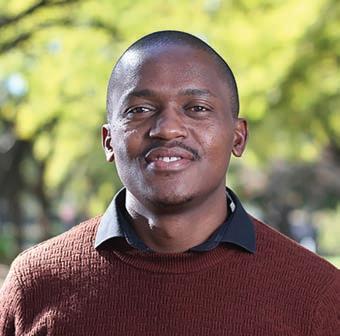
results while nurturing future leaders in this area. Our executive course allows you to learn from your peers, industry experts and our expert academics. Studying at the WSG enables you to connect with peers from diverse industries and enhance your personal and professional network,” says Hopane.
WSG offers a range of academic programmes and executive courses. On offer is a postgraduate diploma in management, master of management and PhD studies. Online options are available for the postgraduate diploma in management.

Scan to go to the WSG website

For more information: www.wsg.ac.za
The vast region of the Northern Cape has, over the past few decades, become a significant region for astronomy in South Africa and internationally. The unspoilt landscape of the Karoo, which is largely free of light pollution and radio interference, makes the ideal conditions for astronomy research.
Sutherland, about 346km from Cape Town, is well known for its snowy landscape during winter, but the town is also home to the South African Large Telescope (SALT), a site housing several huge optical telescopes that attract researchers and tourists from around the world annually.
The economically depressed town of Sutherland has experienced a tourism boom over the years as SALT draws scientists and the public, who can enjoy stargazing activities. This has seen a growing hospitality industry providing much-needed jobs to the town’s residents.
About 245km from Sutherland is the small town of Carnarvon, where the Square Kilometre Array (SKA), a mega radio astronomy project, is under construction. The site includes the KAT-7 array and the MeerKAT array, and will soon be home to a huge number of dishes spread across a wide expanse of land. The SKA, which includes

dishes in Australia, will become the world’s largest radio telescope on completion in 2050.
The SKA has already attracted scientists and tourists from around the world. With the construction of a visitors’ centre, even a larger number of people will continue to flock to the area, fuelling the growth of the hospitality sector.
Like those in Sutherland, the community of Carnarvon and its surrounds will benefit from the opportunities created by these scientific sites. Work by the Department of Science and Innovation (DSI) and the Department of Tourism has seen the development of South Africa’s Astro-Tourism Strategy. Both the Minister of Science, Technology and Innovation, Prof Blade Nzimande, and Minister of Tourism, Patricia De Lille, launched the strategy on 27 September 2024, also known as World Tourism Day.
In Carnarvon, young resident Amy-Lee Visagie is excited to be one of six young people who have been trained to become astro guides (cultural guides) by the South African Radio Astronomy Observatory (SARAO), an entity of the DSI.
She says with this initiative, SARAO aims to delight visitors by combining indigenous astronomy

stories told for generations by our ancestors with modern scientific facts.
According to SARAO’s Dr Anton Binneman, the “astros” gained hands-on experience by travelling across South Africa, including visiting key locations, such as the Hartebeesthoek Radio Astronomy Observatory in the Magaliesberg hills, and several small towns like Loxton, Sutherland and Loeriesfontein.
This project, funded and implemented by the Northern Cape Department of Economic Development and Tourism, in partnership with SARAO, represents a significant step towards expanding astro-tourism to other Karoo towns and the Kalahari.
Dr Binneman says the success of the astro guides is a testament to the transformative power of education and opportunity, lighting the way for a brighter future in the Northern Cape.
“The Carnarvon experience is all about mesmerising the world with the unique stories our people had to tell, while leaving our visitors with an immersive feeling they will never forget. Stargazing refreshes our minds because we continuously learn more about the universe beyond our reach,” says Visagie.


“Being part of this amazing programme, I learnt so many astounding things. I also learnt so much about myself as an individual on this journey,” she says.
In 2011, while in Grade 11, Visagie and Chrislin de Koker travelled to France after winning the Global Travel and Tourism Partnership (GTTP) competition. The GTTP is a multicountry educational programme to introduce tourism students to career opportunities in the sector. Carnarvon High School was selected as the winning school in the country for 2018.
The pupils submitted a research piece on astronomy tourism and how SALT and the SKA can benefit the local communities.
Since her GTTP experience, Visagie has not looked back. Today she has qualified as a cultural tour guide who specialises in dark sky tours (stargazing), historic walking trails and indigenous storytelling.
During the International Astronomy Union General Assembly (IAU GA) held in August this year in Cape Town, Visagie was part of the

#AfricaLookUp Cultural Exchange
Evening. The IAU GA attracted about 2 000 astronomers from around the world and many other delegates.
The cultural evening honoured the legacy of indigenous knowledge and celebrated the beauty of cultural diversity. Storytellers from Egypt, Madagascar, South Africa, Ethiopia, Ghana, Mozambique and Britain, among other countries, captivated the visitors with a rich tapestry of cultures and their historic relationship with the skies. Through diverse artistic expressions that included music, dance and poetry, the event delved into the timeless wisdom of indigenous knowledge.
Stories told included the legend from the Khoikhoi and the San communities on how the Milky Way was formed. According to the legend, a strong-willed girl grabbed roasting roots and ashes from a fire and threw them into the sky, angry that her mother had refused to give her any of the delicacies. The roots glowed red and white and the ashes turned into the Milky Way.
According to Visagie, that young girl threw the bright sparks of her fire high up into the sky many,

many years ago to pave a way in the darkness for us today.
In another legend, the Batswana people believed that, after sunset, the sun travelled back to the east over the top of the sky and the stars were small holes that let light through. Others said the sun is eaten each night by a crocodile and emerges from the crocodile each morning.
Visagie says when people in Carnarvon look up and see the Scorpius constellation, they envision a giant snake with three heads, covered in jewels and pearls from head to tail. Scorpius is one of the most ancient and the most recognisable constellations in the night sky and is described as a scorpion in mainstream astronomy.
It is these kinds of fascinating local legends and other cultural interests that the public can look forward to when visiting the scientific wonders in the Northern Cape. The astro guides will keep you enthralled and take you on a journey of celestial discovery when you participate in the Carnarvon astronomy tour.

Access to hot water may be a norm in many households in South Africa, but for the residents of many villages in provinces like Limpopo, it remains a luxury.
This was the case for residents from the Ga-Maja village, who once relied on costly, often unreliable, electricity to heat water. Innovative and sustainable technology, such as the development of a low-cost solar water geyser, has changed their lives.
Matilda Knill, director of energy company Township Green, recently demonstrated how low-income households are reaping the benefits of the low-cost solar geyser.
The demonstration took place at the Serobi Maja Youth Development Centre in Ga-Maja village, Polokwane. The youth centre, a key commercialisation and job creation partner, also benefitted from the technology.
The centre is dedicated to empowering young people in the local community. It offers various courses such as hospitality, dressmaking, computer literacy, dance, farming, flower arranging, bricklaying and plumbing.
The demonstration was attended by key stakeholders, including representatives of the Polokwane Municipality, the Department of Science, Technology, and Innovation (DSTI), and the Technology Innovation Agency (TIA), the DSTI’s entity.


Township Green received funding from the Technology Acquisition and Deployment Fund (TADF), which was developed to promote and enable the acquisition and deployment of locally developed technology solutions by the public sector. The TADF was launched in 2021 and is being implemented by TIA.
The low-cost solar water geyser is 100 per cent South African, from design to manufacture and materials, has a projected lifespan of over 30 years and is almost indestructible.
According to Knill, the geyser is made of corrosion-free and leak-proof materials and has been impact-tested to withstand even the most severe conditions.
“With a tested maximum temperature of 56°C at sea level, you can be confident that your water will be heated to the ideal temperature, even on the coldest days. The unit connects to the water tank and complements the solar panels,” she said.
Thabang Mapheto, one of the beneficiaries of Township Green’s job creation programme, said the

geyser would help mitigate the high cost of living.
“Hot water makes life easier. The solar geyser saves a significant amount of electricity by reducing the time and money we would normally spend boiling a kettle of water for a simple cup of tea,” said Mapheto. “I am grateful that, even in this economy, there are still ways to live an eco-friendly life that is both effective and efficient,” she added.
So far, 19 units have been installed in Seshego and 20 in Ga-Maja village in the Capricorn District Municipality. The installation of the water geysers at the centre represents more than just a technological advancement; it is a step towards energy independence, economic resilience and environmental stewardship.
“With continued support from local leaders, government agencies and the private sector, this sustainable solution has the potential to reshape how rural communities access essential services, ensuring a brighter, more sustainable future for all,” added Knill.


Growing up in the heavily polluted town of eMalahleni set the direction of Prudence Simelane’s life.
The town is in Mpumalanga, the heart of the country’s coal industry, and fly ash from the mines is everywhere. The air in the area is some of the most polluted in the world. Fly ash particles are toxic, causing cancer, lung disease, heart disease and strokes. When they leach into the earth, they contaminate groundwater and the soil.
This situation was something Simelane could not accept. She dreamt of a future with clean air and homes, roads, schools, hospitals and shopping centres built with environmentally friendly products.
Some people just dream. Simelane, however, turned her dream into reality and established Samanjalo, a company that uses technology to turn coal waste into green products – green cement, bricks, pavers and barricades – used in the construction and infrastructure sector.
“If the technology could be rolled out across the country, the continent and the world, the Earth would boom with circularity,” says Simelane. “Let’s transform the way we do business and save the only planet we have.”
South Africa is the highest producer of coal on the African continent. About 50 million tonnes of coal ash

are produced annually and only 10 per cent of this is recycled. This causes air pollution, soil quality degradation and the destruction of wildlife and biodiversity, which affect human health, agriculture and the tourism industry.
Simelane points out that this is a problem in many parts of the world, but not enough is being done to mitigate the effects by turning harmful products into sustainable ones. Samanjalo is working to change this.
“At Samanjalo, we are reducing carbon emissions by extending the circularity of coal waste. We use geopolymer technology to turn fly ash into various environmentally green products that can be used in different industries. We are currently using geopolymer technology to create bricks with three times more strength than existing ordinary products.”
Simelane believes there are endless possibilities for using this technology to create green products.
Samanjalo is one of the seven small, medium and micro enterprise (SMME) winners of the 2024 Irish Tech Challenge South Africa, a competition led by the Embassy of Ireland in South Africa in partnership with Wits University’s Tshimologong Digital Innovation Precinct, the Department of Science, Technology and Innovation, the Technology Innovation Agency and Dogpatch Labs.


The seven SMMEs selected from among over 350 South African-owned, growth-stage tech start-ups focused on the Sustainable Development Goals were given intensive pre-acceleration training and mentorship in South Africa before heading to Dogpatch Labs in Dublin for an acceleration programme.
Simelane describes being chosen as a “massive” boost. “It is an affirmation that Samanjalo’s vision is worthwhile and that patience pays.
“For us, this has transcended being mentioned as another business. The Irish Challenge has made us feel like we have been heard for our story and the difference we wish to make to our community, our town, our country, our continent and the world at large,” she adds.
So far Samanjalo employs 13 full-time staff, with skills in finance, marketing and bricklaying, among others. The tested prototypes of the products are available and approved at a semi-industrial scale and are expected to reach the market soon.

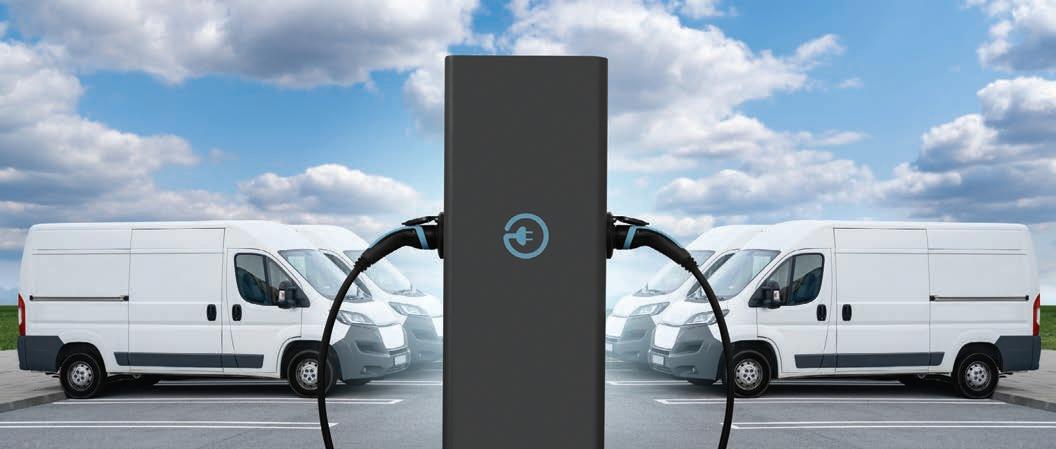
There are many economic and environmental benefits for the South African taxi industry in moving towards electric vehicles. But that means dealing with a complex web of issues, suggests a paper, presented by authors A JAHUR, MJWA VANDERSCHUREN and MJ BOOYSEN at the Southern African Transport Conference, outlining some key considerations
South Africa’s minibus taxi industry is a key part of the country’s economy, providing affordable, accessible mass transport. At the same time, the taxi eet uses carbon-emitting internal combustion engines (ICE). The electri cation of the minibus taxi sector must be considered to reduce South Africa’s environmental impact.
However, this is a complex process – electri cation will introduce many challenges, including the importance of electric vehicle upskilling in the Southern African transport sector.
South Africa’s minibus taxi industry is the main mode of transport for approximately 10.7 million citizens, according to a Stats SA National Households Travel Survey Presently, there are approximately 250 000 to 300 000 minibus taxis in the country, belonging to an estimated 20 000 owners and 1 200 taxi associations.
ENVIRONMENTAL IMPACTS
Global EV Outlook reports that In 2022, 14 per cent of all new cars sold worldwide were electric vehicles (EVs), while in South Africa only 0.1 per cent of vehicles sold in the same period were electric. This is an issue from an environmental and economic standpoint, as the transport industry is responsible for 20 per cent of total carbon emissions, according to IEEE.org, and the third-highest contributor to air pollution in the country.
Building a charging network for the minibus taxi industry would almost certainly be out of reach for private enterprise alone.
National Households Travel Survey

For the electric taxi transition to have optimal environmental bene ts, it would have to coincide with a move to a cleaner national energy mix incorporating more renewables. Currently, Eskom provides the bulk of the country’s energy, mostly from coal- red power stations.

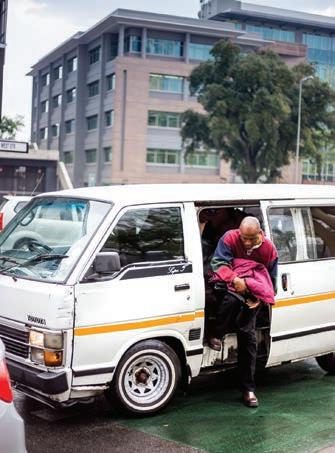
With South Africa lagging in terms of electric vehicle adoption, the paper’s authors write that “stronger efforts are required to ensure the country’s automotive industry transitions to electric mobility”.
They say that considering the importance of minibus taxis to South African paratransit, our EV transition must prioritise minibus taxi electri cation. Complicating this transition is a complex web of factors.
Currently, minibus taxi travel is loosely scheduled and timetabled. Taxis with licences for speci c routes aim to complete trips at particular times of the day, with daily operations dependent on passenger demand.
There is exibility – drivers pick up or drop off passengers at sub destinations depending on their needs. However, for electric vehicles, where ranges and charging locations are limited, more formal schedules and timetables will likely be required.
The paper suggests that taxi owners and associations work with government and technical experts to decide how taxis will balance charging schedules with daily trip planning. Local politics will also play a role, in terms of routes and relations between taxi associations.
As of September 2023, there were more than 2 200 registered electric vehicles and
There are significant cost di erences between the petrol minibus taxis currently used and their equivalent electric counterparts.
approximately 435 total charging stations in South Africa, reports My Broadbrand, with these numbers growing steadily. To accommodate the country’s entire network of minibus taxis, a signi cantly greater number of stations would be required.
Currently, South Africa’s charging infrastructure is funded by the private sector. However, building a charging network for the minibus taxi industry would almost certainly be out of reach for private enterprise alone. The authors recommend that government and/or international funding agencies be involved if the business case for electric minibus taxis can be proven.
There are signi cant cost differences between the petrol minibus taxis currently used and their equivalent electric counterparts. A new Toyota Hi-Ace Ses’ kile 2.5D 16-seater petrol minibus taxi currently costs around R543 900 while the World Bank puts the cost of an electric minibus taxi at approximately R830 000 before shipping and import duties.
“South Africa’s minibus taxi industry must investigate options for producing electric taxis locally to minimise capital costs,” the authors write.
It is also possible to cost-effectively retro t existing ICE minibus taxis with
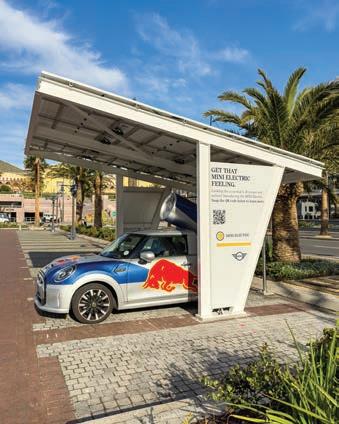

an electric battery, motor and other components, this could make a more practical way to electrify eets.
Battery capacity and the associated range achievable on a single charge have been some key limitations of electric vehicles.
Optimal operational planning will be required to maximise the number of trips electric minibus taxis can complete without recharging while integrated battery swopping can enhance ef ciency at charging stations.
Even optimistically assuming a taxi would have a 100kWh battery, this implies only 200km of range. Current ICE taxis have a range of 500km+ on a full tank. This highlights the need to ensure ranges are maximised through ef cient driving if electric taxis are to complete all daily trips. A study on the in uence of driving style, infrastructure, weather and traf c on electric vehicle performance, published on sciencedirect.co, shows, for instance, that aggressive driving consumes more energy.
The authors recommend that further research be conducted into the social aspects of electrifying the minibus taxi industry and note that regulation will affect its success.
Electri cation of the critical South African taxi industry is a complex process, and the authors recommend that role players consider the various factors as “cogs in one big wheel of electri cation instead of individual problems that must be solved independently”.
Political will and funding are crucial for improving road safety in South Africa, emphasising shared responsibility and behavioural change among road users for better outcomes, writes MATTHEW HIRSCH
There must be political will and dedicated funding to address road safety issues in South Africa, says Karien Venter, a senior researcher in mobility at the Council for Scienti c and Industrial Research (CSIR). “We are a lawless, impatient and violent society, and this behaviour manifests on the roads. Secondary issues, such as driving unroadworthy vehicles, driving under the in uence, using mobile phones while driving and knowingly exceeding the speed limit, are examples of this,” says Venter.
She adds that the government’s Safe System Approach advocates that road safety is a shared responsibility. “From an institutional management perspective, we must take ownership of the problem.”
Venter stresses that ensuring drivers are well-equipped to drive safely should be a priority. “Speed needs to be actively managed and there should be consequences for repeat offenders who break road rules. Road safety considerations should be part of the planning and design of roads and infrastructure, rather than an issue dealt with after construction,” she says.
Venter also notes that moving freight from road to rail could address road safety by easing congestion, reducing con ict and prolonging the lifespan of roads. “However, freight is a huge contributor to the economy, and roads are currently the backbone facilitating the distribution of goods and people,” she adds.
An increase in public transport use could potentially improve road safety, Venter suggests, but cautions that providing safe
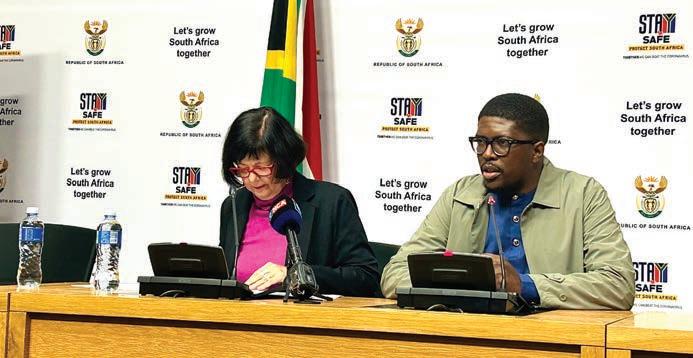
and accessible transport alone would not necessarily prompt a shift from private vehicles to public transport. “Convenience, affordability, and the ability to choose a mode of transport are key considerations,” she says.
During the recent budget votes in parliament, Deputy Transport Minister Mkhuleko Hlengwa noted that while roads carry 88 per cent of all freight, they also account for 98 per cent of personal trips.
“The latter, referring to the transportation of people, raises important questions about the quality and safety of public transport across our road infrastructure. Even though human factors play a primary role in crashes, followed by vehicle factors, we cannot ignore the quality of our roads,” Hlengwa told MPs.
He stressed that road users must take equal responsibility for their safety and the safety of others. Hlengwa pointed out that approximately 10 per cent of vehicles on the road are unroadworthy, while around 40 per cent of vehicles are uninsured.
“Research shows that changing road user behaviour is central to making our roads safer. Statistics indicate that up to 87 per cent of road fatalities in the country are linked to road user behaviour. This compels us to implement a behaviour change programme across the road sector.”
Hlengwa highlighted the challenge of pedestrian deaths, the highest segment of road fatalities. “Given our growing population and expanding urban areas, we are committed to tackling pedestrian fatalities.”
He also announced the department’s plan to implement “Accessible Transport for All’, which emerged from the recent Summit on Universal Accessibility hosted by the department.
In the 2024/25 nancial year, Hlengwa said the department would conduct roadshows across the provinces to advance these commitments and resolutions.
Hlengwa further noted that the Department of Transport’s review of cities in 2023/24, focusing on Integrated Public Transport Network implementation programmes, identi ed the need for more specialised skills at the city level. The review also recommended stricter controls over wasteful and irregular spending of Public Transport Network Grant funds.
“Cities have been put on notice to improve in this regard and to eliminate bottlenecks that hinder increasing ridership while reducing costs.
“With the 2024/25 allocation of R7.5-billion under the Public Transport Network Grant, we will insist on better implementation performance. We will also strongly discourage operational delays,” he concluded.
“Road safety considerations should be part of the planning and design of roads and infrastructure, rather than an issue dealt with after construction.”
– Karien Venter

As cities worldwide race to modernise, South Africa finds itself on the brink of its own smart city revolution. Smart cities, where technology, sustainability and data-driven infrastructure converge, are fast becoming a necessity. By BRENDON PETERSEN
In a country grappling with energy shortages, water scarcity and inequality, the need for smarter urban solutions has never been more urgent. For Andrea Sorri, segment development manager Smart Cities EMEA at Axis Communications, smart cities are about more than just technology. “They’re built around the needs of the people who live in them,” Sorri says. “The goal is to improve the quality of life for everyone –not just a select few.”

Globally, the smart city market is projected to reach $3.1-trillion by 2030, and South Africa has the potential to bene t greatly. Smart grids could help manage energy demand and reduce strain on the national power system. Water management systems, using advanced sensors and real-time data, could help prevent crises such as Cape Town’s “Day Zero”.
However, Thabang Byl, buildings segment lead at Schneider Electric,
highlights a key challenge: “A smart city cannot function without stable, reliable power. In South Africa, modernising the grid must be the rst step.” The country’s frequent blackouts present a major hurdle. Without a reliable power supply, smart city technologies remain an elusive dream.
inequalities. Affordable housing, public transport and energy access must be part of the equation. “The beauty of smart technology is that it can be used to bridge social divides,” Byl says. Energy-ef cient buildings that can generate their own electricity, for example, could provide affordable power to underdeveloped areas.
Environmental sustainability is another critical aspect. Cities are responsible for 70 per cent of global energy consumption, and South African cities, such as Johannesburg and Cape Town, struggle with pollution and inef cient energy use. Both Sorri and Byl stress that smart cities must incorporate green infrastructure, such as urban forests and rooftop gardens, to mitigate climate change and improve quality of life.
The challenges don’t end with infrastructure. As cities become more connected, security and data privacy become paramount. Sorri warns that with the rise of internet of things devices and sensors, managing large amounts of data securely is crucial. “As smart cities grow, we need to ensure that systems are not only scalable, but also secure,” he says.

While the concept of a smart city is appealing, there are concerns about equity. In a country where inequality is deeply entrenched, smart cities risk becoming another tool that bene ts the wealthy while leaving poorer communities behind. Sorri acknowledges this, emphasising that inclusivity is essential. “A city can only be as smart as its ability to include all citizens. We need to ensure smart cities bene t everyone, not just the wealthy.”
For Byl, this means designing solutions that address South Africa’s social
“The
Some progress is already visible. High-end developments such as Steyn City near Johannesburg showcase what’s possible. These mini smart cities operate largely autonomously with their own power and water systems, but critics worry that such developments only serve the wealthy. To see the bene ts of smart cities expanded across South Africa, collaboration between public and private sectors is essential.
Ultimately, Byl and Sorri agree that the path forward for South Africa lies in making smart cities not only technologically advanced, but also equitable. “The goal is not just to build smarter cities, but also to build better cities,” Byl says. As South Africa moves towards this future, the challenge will be to ensure that the bene ts of smarter cities reach all its citizens, not just a privileged few.
goal is not just to build smarter cities, but also to build better cities.”
– Thabang Byl

CARRIE PETER, managing director at Impression Signatures and the Advocacy Committee vice chair at the Cloud Signature Consortium, says the South African government’s recent policy shift points the country to the cloud
Earlier this year, the South African government published a new policy setting out its approach to cloud services. The overarching message is clear: cloud is the future. With a view to overcoming Africa’s general lack of infrastructure, this fundamental shift away from traditional, expensive on-premise approaches offers a wealth of opportunities. With it comes the chance for government departments to nd affordability and ef ciency in IT applications.
In South Africa, infrastructure limitations severely hinder the government’s ability to leverage on-premise solutions. Consider the sheer scale of what would be needed for every government department, of ce, service delivery hub or municipality to have a fully functioning on-premise IT infrastructure – not to mention the cost of
failovers, backup power or maintenance. Add to this the security risk of widespread, unmaintained on-premise infrastructure and cloud simply makes good sense.
Consider this. A single tier-one data centre in Europe holds 20 units in each block and has six blocks on the campus. Each unit has two electricity lines (main and failover), two water cooling lines, two backup generators per electricity line, and two backups per water line. For each backup generator, it has another backup generator – 16 generators per data centre, along with fuel tanks to run the generators when needed. All this just to have a 24-hour failover. It’s impossible to maintain this level in South Africa.
Enter this new government policy and the country is nally moving in the right direction.
This fundamental shift away from traditional, expensive on-premise approaches o ers a wealth of opportunities.

The policy clearly sets out guidelines on why procuring cloud- rst is paramount for the future of an ef cient and effective government and business economy. From cost savings to pooled data, higher visibility and availability, always-on services, priority and support for cybersecurity and the fostering of true digital trust – the rationale behind the policy is forward-thinking, driving enforcement and ef ciency.
The top takeaways from these guidelines include:
• First, and quite simply, a cloud- rst approach must be chosen because the country’s infrastructure simply cannot support on-premise for every department.
• Second, cloud- rst will give departments pooled and centralised data sets, eradicating siloed data


• Third, the shift to cloud across the globe, leading to greater support for cloud computing – and offering the opportunity for a single cloud instance, which is far easier to secure than innumerable on-premise instances. Here is where the real value shines through.
• Fourth is the support that this policy lends to creating a digital trust environment. This will inevitably support economic development by eliminating fraud. A lack of identity certainty or not being unable to verify identity (whether juristic or natural) opens the door for fraudsters. This is why many government grants are going to people who don’t deserve them. This digital trust element must be applauded. When digital identities are irrefutably proven, the door for fraudulent activity is rmly shut.
• Fifth is the value of data that is consistently available, accurate, complete, unique and valid. Leveraging this value requires a cloud approach –especially considering South Africa’s energy challenges and the constant threat of looming load shedding. It is clear that African countries cannot provide 100 per cent on-premise uptime, and this is where cloud really comes into play. This always-on cloud capability ties into the necessary ability
to sign documents electronically, which is as important as being able to access electronic data at all times.
When it comes to global interoperability, a cloud- rst approach will certainly empower Africa to do business effectively with the rest of the world. The policy covers the conclusion of the African Continental Free Trade Area and details how the African Single Digital market and digital identity will rely signi cantly on data-sharing within different jurisdictions.
This is a strong move toward continental interoperability and a massive opportunity for cloud-based identity solutions throughout Africa. A 2022 Centre for Economics and Business Research report con rms that a one per cent point increase in digital trust results in an average $600 increase in gross domestic product per capita – making it a key driver of economic growth.
Of course, this is just one of the opportunities presented by a cloud- rst approach. While each opportunity also represents an obligation, the ways in which

this government shift will create ef ciencies are endless. From taking moments of consent when a person signs a document electronically and automatically converting it into an irrefutable digital document with a proven chain of custody to the provision for the creation of a Cyber Security Commissioner – the intent is clear. Digital is the way forward.
A critical consideration is the necessity to roll out digital services with empathy for less tech-savvy citizens. Participating in this move to cloud demands putting citizens rst. The technology must offer easy, frictionless processes. Impressions’ digital signatures, for example, can be run on a USSD system, ensuring citizens are empowered to use the technology with ease. While we are delighted at the idea of moving to a digital, cloud- rst world, it will remain the service provider’s duty to ensure none of the complexity is passed onto the end user.
The tech service providers that are perfectly positioned to address the needs created by this policy are those that have a full understanding of the African environment, offer cybersecurity and privacy by design, already follow a cloud- rst ethos, hold security audits, such as WebTrust or ISO, drive rapid digitisation and deployment, offer end-user empathy and inclusivity – even to those who don’t have sophisticated hardware, have a mobile solution and don’t force users to have an email address to be able to prove their identity or sign a contract digitally.
A cloud-first approach will certainly empower Africa to do business e ectively with the rest of the world.
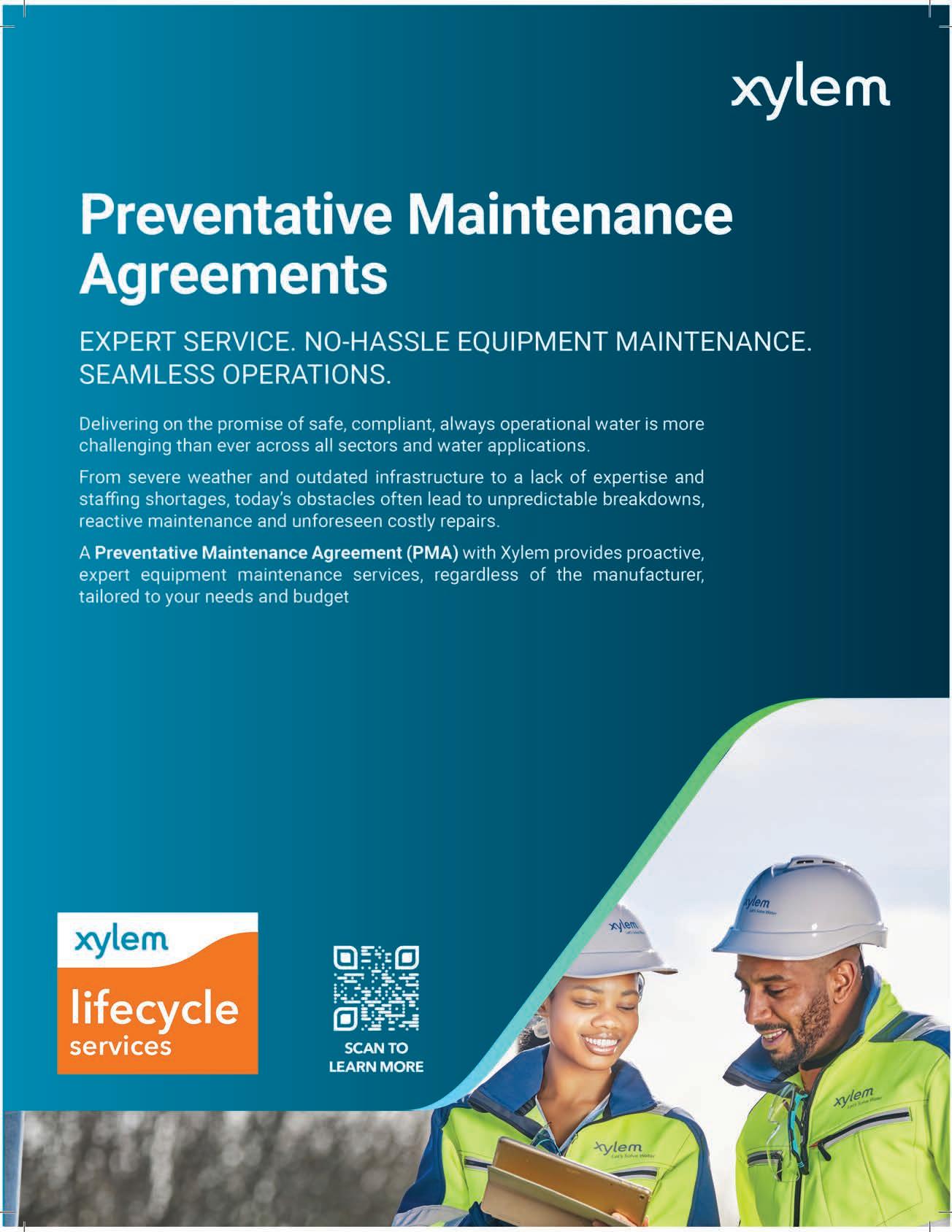
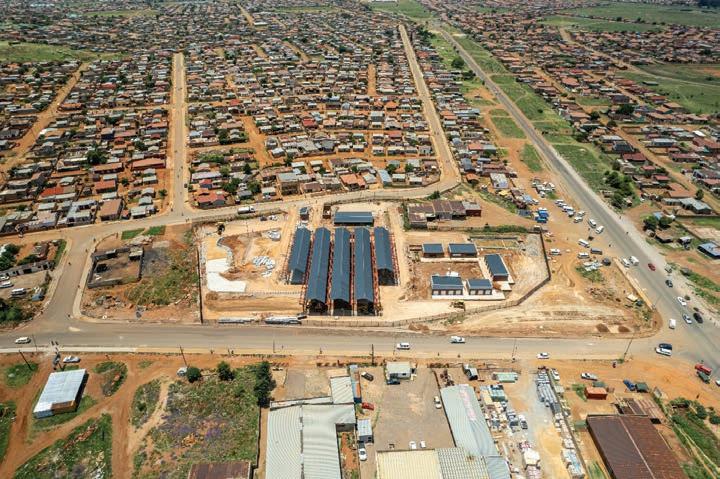
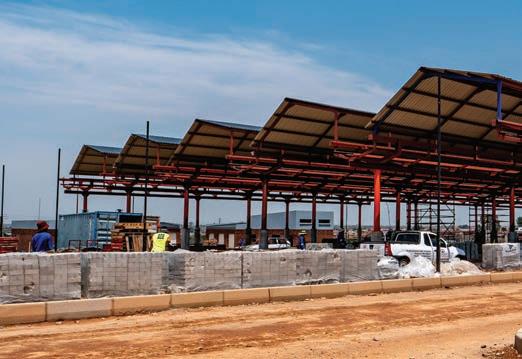

A roundup of service delivery wins across the country: City of Johannesburg’s Accelerated Service Delivery programme; Greening Alexandra township; eThekwini’s focus on governance; Cape Town prepares to tackle joblessness and water security; Transforming Orange Farm; Drieziek Recreation Park.
• The Western Cape municipalities consistently outperform other provinces with 15 of the top 20 municipalities located there.
• The Swartland Municipality achieved the highest overall Governance Performance Index (GPI) score, followed by Drakenstein and Saldanha Bay.
• Mixed performance in metropolitan municipalities: while Cape Town and Ekurhuleni demonstrate strong performance, other metros, such as Johannesburg and Tshwane, face challenges.
• Factors influencing GPI: key factors impacting GPI scores include province, Municipal Infrastructure Investment Framework classification, population density, historical GPI performance and effective leadership and management.
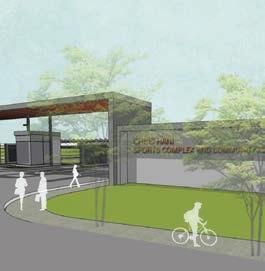
• Homeland/traditional authority areas hinder service delivery: municipalities with a history of homeland or traditional authority governance tend to have lower service delivery access when compared to those without.
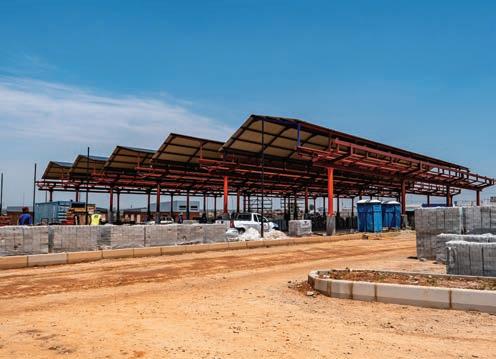
• Coalition agreements can improve governance: Ekurhuleni’s positive performance during a period of formal coalition governance highlights the potential benefits of such arrangements.
• Challenges in Eastern Cape and KwaZulu-Natal: these provinces face significant challenges in local governance with several municipalities ranking low in the GPI.
• Need for institutional strengthening: the report emphasises the importance of strong institutions, such as the Auditor-General and National Treasury, for effective local governance.
• Citizen engagement is crucial: active citizen participation in local governance is essential for holding elected officials accountable and improving service delivery.

• Opportunities for improvement: despite existing challenges, there are opportunities for positive change through targeted interventions and improved governance practices.
Governance Performance Index – South Africa 2024 DOWN LOAD





LISA WITEPSKI looks at local government projects moving metros forward
That Johannesburg’s communities experience service delivery issues is a well-known fact. Less known, however, is where the breakdowns and shortfalls causing these issues lie.
Identifying these problem areas is the aim of the Accelerated Service Delivery programme, which Gauteng Premier Panyaza Lesufi and Johannesburg Mayor Dada Morero launched in Moletsane, Soweto, on 6 September 2024.
The programme represents a pragmatic approach to solving service delivery issues by finding problem areas and taking steps to address them. For example, low water pressure in the region is being resolved through upgrades to the Jabulani Reservoir over the next 24 months.
The reopening of the Eldorado Park power station is another action that has helped to address load reduction caused by illegal connections while ongoing efforts to repair electrical transformers will further contribute to a stable power supply.
The City of Johannesburg is one of several stakeholders to have joined forces with Scaling Urban Nature-based Solutions for Climate Adaptation in Sub-Saharan Africa (SUNCASA), an initiative established by Alexandra resident Semadi Manganye.
SUNCASA is a sister association to Manganyane’s Alexandra Water Warriors, which aims to clean up the polluted Jukskei River running through the township. This pollution frequently leads to flooding, affecting the homes located on its banks.
SUNCASA, too, seeks to end flooding by greening Alexandra. This will have a three-fold benefit: reducing

The launch of the programme saw Premier Lesufi and Mayor Morero walking the streets of Moletsane as they discussed solutions – this model sets the tone for the programme going forward with walkabouts set to take place in communities every Friday, marking a departure from talking about service delivery to actively seeking solutions, Minister Lesufi said.
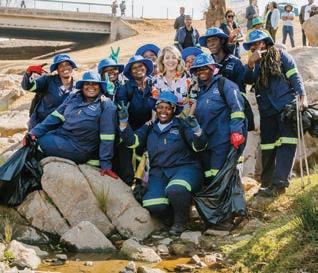
the risk of flooding, increasing the number of trees and shrubs in the township to lower urban heat and providing access to green spaces for residents.
The City of Johannesburg is joined by the Johannesburg Inner City
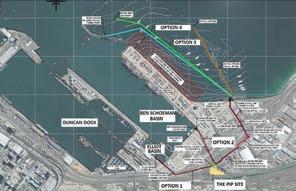
The City of Cape Town has embarked on feasibility studies for the Paarden Eiland Desalination Plant and Faure New Water Scheme, aiming to diversify drinking water supply resources.
With the reality of climate change becoming ever more apparent and the memory of the 2018 water crisis still very fresh, the City of Cape Town is launching a feasibility study for a new desalination plant. The study aims to identify the best options for the construction, financing and operations of the Paarden Eiland Desalination Plant and Faure New Water Scheme. It is hoped that the plant will produce 50–70 million litres of water a day; a target set for 2030. The city is also investigating other sources, such as groundwater, clearing of alien vegetation, desalination and water reuse, to add an extra 300 million litres of water per day to Cape Town’s supply.
Partnership, Johannesburg City Parks and Zoo, Water for the Future, Zutari and GenderCC in supporting the initiative, which is funded through Canada’s Partnering for Climate Initiative and led by the World Resources Institute and the International Institute for Sustainable Development.
The City of Johannesburg has designated the Greater Orange Farm region as a priority intervention area, necessitating tailored short- to medium- and long-term development programmes and strategies guided by a clear vision for a brighter future
The City of Johannesburg’s strategy to transform Orange Farm into a hub of opportunity focuses on developing essential infrastructure, attracting investment and enhancing the capacity of residents to seize new opportunities.
The Orange Farm Turnkey Programme relates to creating neighbourhoods through spatial interventions including:
• Infrastructure development, basic services and social facilities, and improving mobility by investing in new linkages, internal road infrastructure and public transport.
• Attracting investment and new opportunities into the area through partnerships and growing local informal and micro enterprises.
• Building the human capacity within Orange Farm through improving the physical health, safety and wellbeing of residents.
As the infrastructure arm of the City of Johannesburg, the Johannesburg Development Agency (JDA) has been spearheading the implementation of the multidisciplinary turnkey projects in Orange Farm valued at R625-million.
PUBLIC WORKS TO BE COMPLETED
In Lakeside, Orange Farm, the JDA’s catalytic interventions will see 2.5km of roads being upgraded from gravel to tar in Wards 1, 2, 3, 4, 5 and 131. The overall scope of works includes the regravelling of access roads, installation of stormwater infrastructure, public environment upgrades and streetlights.
The JDA has also commenced with other projects within Ward 3, projects namely on 16th and Moyane Drive public environment upgrades and the continuation of stormwater upgrades on Ingonyama Street. Both these
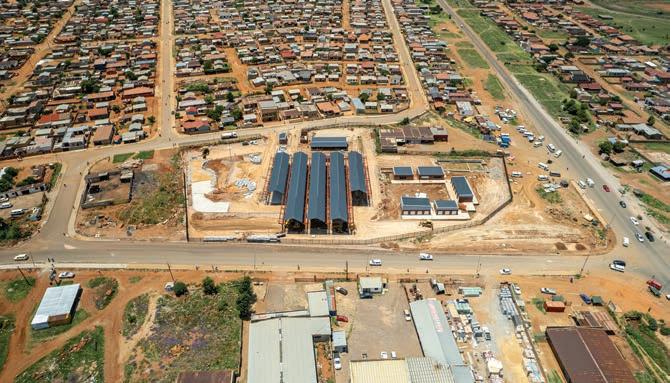
projects are due to be completed by the end of 2024.

The Orange Farm Public Transport Facility, situated at the corner of Link and Saint Road, is currently 88 per cent complete. Designed to be aesthetically pleasing, functional, sustainable and durable, the facility will also feature greening and landscaping.
The R55-million Orange Farm public transport facility will meet the evolving needs of public transport in the area, offering a safe and inclusive commuter experience for people with disabilities, women and children.
The facility will include covered trading areas, ablution facilities, bicycle racks and a refuse yard. Additionally, the landscaping will feature street furniture and a security officer post with a mini kitchen and a boardroom for meetings. Streetlighting and
perimeter lights will ensure safety within a suitable radius of the facility.
CHRIS HANI SPORTS COMPLEX CHALLENGES TO BE RESOLVED

The JDA is dedicated to implementing the Chris Hani Sports Complex project on behalf of the City’s Community Development Department. However, the Chris Hani Multipurpose Centre has been temporarily halted due to the main contractor’s cash flow issues. The JDA is actively working to resolve these challenges.
The development objectives of the Chris Hani Sports Complex include:
• Enhancing the complex with additional sports facilities.
• Promoting sports excellence among youth.
• Improving integration between the sports complex and the surrounding precinct.
• Enhancing the visibility of the complex with defined links, clear gateways and entrance points.
The Johannesburg Development Agency, the infrastructure arm of the City of Johannesburg, has commenced the construction of the Drieziek Recreation Park as part of the Orange Farm Turnkey programme
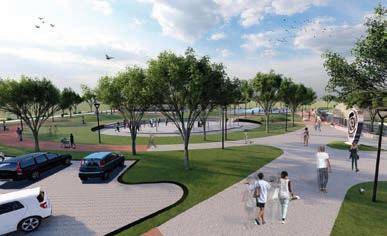

The Drieziek Recreation Park development marks a significant milestone in enhancing the quality of life for residents of Drieziek Extension 3, underscoring the City’s commitment to fostering community wellness and social cohesion.
Parks are integral to improving the wellbeing of urban dwellers, especially in densely populated areas such as cities and townships. They serve as sanctuaries from the stresses of daily life, fostering a sense of connection with nature and promoting physical and mental health.
Recognising this, the Johannesburg Development Agency (JDA) has started construction of the Drieziek Recreation Park to provide a dedicated space for families, social groups and individuals to come together, engage in recreational activities and lead healthier lifestyles.
The JDA is committed to managing and facilitating infrastructure projects with efficiency and innovation, and its vision is to build an equitable, sustainable and resilient city. In collaboration with Johannesburg City Parks and Zoo, the entity
responsible for greening initiatives in the city, the JDA is spearheading the implementation of the Drieziek Recreation Park.
THE DRIEZIEK RECREATION PARK INTENTIONS
•Promote healthy lifestyles: the park is designed to encourage physical activity and wellness among residents, providing amenities such as play and exercise equipment, multipurpose courts and a futsal court.
•Enhance community engagement: by offering a designated gathering space, the park aims to foster social interaction and strengthen community bonds, contributing to a sense of belonging and collective ownership.
• Facilitate sustainable practices: with features such as urban agriculture and sustainable landscaping, the park seeks to promote urban farming and resilience within the community.
The development objectives of the Drieziek Recreation Park are to create a safer and more functional recreational space that caters to the diverse needs of residents.
Parks are integral to improving the wellbeing of urban dwellers, especially in densely populated areas such as cities and townships.

Through extensive stakeholder engagement, including input from the community, the park’s design has been refined to reflect the unique preferences and aspirations of its future users.
In addition to its social and environmental impact, the construction of the Drieziek Recreation Park holds economic significance for the local community.
The JDA is committed to supporting small, medium and micro enterprises (SMMEs) and fostering entrepreneurship by increasing opportunities for local emerging contractors and creating jobs and Expanded Public Works Programme opportunities focused on empowering women and youth in the construction sector.
Thirty per cent of the contract value will be allocated to SMMEs, demonstrating a commitment to inclusive growth and economic empowerment.
“The Drieziek Recreation Park stands as a testament to the JDA’s dedication to holistic urban development, where infrastructure projects not only meet the needs of residents, but also contribute to the social, economic and environmental wellbeing of the community,” comments Siyabonga Genu, JDA’s executive manager for project implementation.
